 The BBC (British Broadcasting Company, as it was known at the time) started the world’s first regular high definition – ‘high’ in this case being relative to what was technologically possible at the time – public television service at 3 p.m. on 2 November 1936, transmitting 405-line black-and-white pictures from Alexandra Palace (London) to an audience of less than 400 sets. The transmitter range was only 30 miles, and programming was very minimal to begin with – an hour in the afternoon and an hour in the evening, and nothing on Sundays until February 1938 – due to a lack of budget and studio facilities (only one studio available until 1938 when the second studio housing the Baird camera was recommissioned) and also due to early concerns about eye strain, though staring for long periods at a small flickering screen must have been difficult.
The BBC (British Broadcasting Company, as it was known at the time) started the world’s first regular high definition – ‘high’ in this case being relative to what was technologically possible at the time – public television service at 3 p.m. on 2 November 1936, transmitting 405-line black-and-white pictures from Alexandra Palace (London) to an audience of less than 400 sets. The transmitter range was only 30 miles, and programming was very minimal to begin with – an hour in the afternoon and an hour in the evening, and nothing on Sundays until February 1938 – due to a lack of budget and studio facilities (only one studio available until 1938 when the second studio housing the Baird camera was recommissioned) and also due to early concerns about eye strain, though staring for long periods at a small flickering screen must have been difficult.
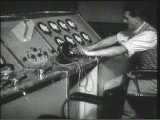 Lord Selsdon’s Committee, set up by the Postmaster General in 1935 had advised that the BBC should hold a public trial of the two systems proposed – Baird’s 240-line mechanical scanning system and Marconi-EMI’s 405-line electronic scanning system, so both systems were used on alternate weeks with each system’s equipment housed in separate 40 foot long studios. The Marconi-EMI system was so obviously superior in all respects that the Baird system was dropped by February 1937; Baird’s camera was fixed and required the subject to be specially lit, compared with Marconi-EMI’s cameras which could even be used outside with an extension lead. Baird had tried to overcome camera restrictions using an “intermediate film system” where celluloid film was rapidly processed and fed into an optical scanner, but it became fairly obvious that this cumbersome and expensive technique was merely a stop-gap compared to the Marconi-EMI system’s future potential.
Lord Selsdon’s Committee, set up by the Postmaster General in 1935 had advised that the BBC should hold a public trial of the two systems proposed – Baird’s 240-line mechanical scanning system and Marconi-EMI’s 405-line electronic scanning system, so both systems were used on alternate weeks with each system’s equipment housed in separate 40 foot long studios. The Marconi-EMI system was so obviously superior in all respects that the Baird system was dropped by February 1937; Baird’s camera was fixed and required the subject to be specially lit, compared with Marconi-EMI’s cameras which could even be used outside with an extension lead. Baird had tried to overcome camera restrictions using an “intermediate film system” where celluloid film was rapidly processed and fed into an optical scanner, but it became fairly obvious that this cumbersome and expensive technique was merely a stop-gap compared to the Marconi-EMI system’s future potential.
 Before World War 2 television was slow to catch on, largely due to the limited range of the transmissions, lack of programmes, and the cost of the receivers (£60 upwards) meant that typically only wealthy people could afford them, so programming was aimed generally at this audience; especially as the BBC itself was controlled by people from these affluent social groups.
Before World War 2 television was slow to catch on, largely due to the limited range of the transmissions, lack of programmes, and the cost of the receivers (£60 upwards) meant that typically only wealthy people could afford them, so programming was aimed generally at this audience; especially as the BBC itself was controlled by people from these affluent social groups.
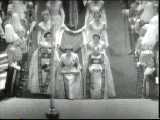 Television was still very much in its infancy when the service restarted in 1946. One set per street was common, and families often visited friends or relatives who had a set in order to watch events such as the Coronation in 1953. Also only two studios were available until 1949 when the BBC opened eight new West London studios (one ex-variety theatre and the rest were converted film studios).
Television was still very much in its infancy when the service restarted in 1946. One set per street was common, and families often visited friends or relatives who had a set in order to watch events such as the Coronation in 1953. Also only two studios were available until 1949 when the BBC opened eight new West London studios (one ex-variety theatre and the rest were converted film studios).
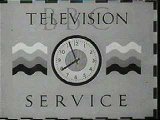 After World War 2 a comprehensive transmitter building programme ensured more people outside heavy populated areas such as London could watch television, though it was slow to progress due to funding restrictions. In 1949 television reached the Midlands, Manchester in 1951, Scotland in 1952, then Wales and the West Country. Lack of signal coverage didn’t stop people living in ‘fringe’ areas putting up large aerials in an attempt to receive some form of television picture even if the end result was unwatchable from time to time due to nearby interference, even though for the first few post-war years television was heavily restricted to a small number of programmes each day, typically starting with a demonstration film in the morning and concluding with a news broadcast being relayed in sound only. Large gaps between programmes were very common, with interlude films or tuning signal captions being displayed between programmes.
After World War 2 a comprehensive transmitter building programme ensured more people outside heavy populated areas such as London could watch television, though it was slow to progress due to funding restrictions. In 1949 television reached the Midlands, Manchester in 1951, Scotland in 1952, then Wales and the West Country. Lack of signal coverage didn’t stop people living in ‘fringe’ areas putting up large aerials in an attempt to receive some form of television picture even if the end result was unwatchable from time to time due to nearby interference, even though for the first few post-war years television was heavily restricted to a small number of programmes each day, typically starting with a demonstration film in the morning and concluding with a news broadcast being relayed in sound only. Large gaps between programmes were very common, with interlude films or tuning signal captions being displayed between programmes.
 On December 2 1953, the BBC introduced a new symbol for use as visual identification (or an ident) for its Television Service, which quickly gained the nickname of “bat’s wings” due to its shape, and was the world’s first animated television ident symbol. Two ‘eyes’ rotated in the centre of a mechanical model whilst flashes of light shone on the wings at quarter-turn intervals; this was constructed as a mechanical model and the animation was filmed because the model was too fragile for regular use. The concept was developed by talented designer Abram Games, who was commissioned by the BBC on the strength of his emblem design for the Festival of Britain in 1951.
On December 2 1953, the BBC introduced a new symbol for use as visual identification (or an ident) for its Television Service, which quickly gained the nickname of “bat’s wings” due to its shape, and was the world’s first animated television ident symbol. Two ‘eyes’ rotated in the centre of a mechanical model whilst flashes of light shone on the wings at quarter-turn intervals; this was constructed as a mechanical model and the animation was filmed because the model was too fragile for regular use. The concept was developed by talented designer Abram Games, who was commissioned by the BBC on the strength of his emblem design for the Festival of Britain in 1951.
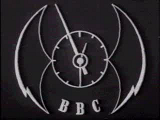 Games also designed this clock as well as static cards featuring a simplified version of the same logo. Both the animated symbol and the clock remained in use until the end of 1959, but static captions featuring the symbol continued to be used until October 1960, whilst elements of the symbol (such as miniature lightning flashes) continued to be used for Schools programming until October 1961. During the mid-fifties, television was becoming more ambitious in terms of quantity and breadth, especially as post-war rationing was gradually coming to an end; programmes during this era included Mainly For Women, quiz show What’s My Line?, comedy series Emney Enterprises, drama serial The Grove Family, children’s favourite The Flowerpot Men and the groundbreaking six-part science fiction drama Quatermass and the Pit.
Games also designed this clock as well as static cards featuring a simplified version of the same logo. Both the animated symbol and the clock remained in use until the end of 1959, but static captions featuring the symbol continued to be used until October 1960, whilst elements of the symbol (such as miniature lightning flashes) continued to be used for Schools programming until October 1961. During the mid-fifties, television was becoming more ambitious in terms of quantity and breadth, especially as post-war rationing was gradually coming to an end; programmes during this era included Mainly For Women, quiz show What’s My Line?, comedy series Emney Enterprises, drama serial The Grove Family, children’s favourite The Flowerpot Men and the groundbreaking six-part science fiction drama Quatermass and the Pit.

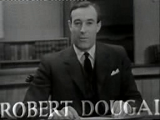
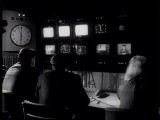 Television was starting to prove that the coverage of news and current events could combine the immediacy of a radio news report with visuals which were far more up-to-date than a cinema newsreel, even if news bulletins in particular were somewhat restricted in terms of what was achievable with the resources available to them. The use of still photographs to illustrate news stories (as opposed to moving pictures) was extremely commonplace, with regional news programmes in particular continuing with the practice into the 1980s primarily due to a lack of resources.
Television was starting to prove that the coverage of news and current events could combine the immediacy of a radio news report with visuals which were far more up-to-date than a cinema newsreel, even if news bulletins in particular were somewhat restricted in terms of what was achievable with the resources available to them. The use of still photographs to illustrate news stories (as opposed to moving pictures) was extremely commonplace, with regional news programmes in particular continuing with the practice into the 1980s primarily due to a lack of resources.
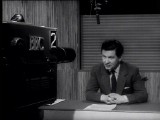 The early post-war BBC news bulletins were often almost identical in format to the newsreels shown in cinemas, but competition from Independent Television News from 1955 onwards caused the BBC to adopt a more flexible presentation format for its bulletins. Shown here is Richard Baker presenting the 6pm news bulletin.
The early post-war BBC news bulletins were often almost identical in format to the newsreels shown in cinemas, but competition from Independent Television News from 1955 onwards caused the BBC to adopt a more flexible presentation format for its bulletins. Shown here is Richard Baker presenting the 6pm news bulletin.
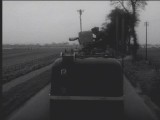 Post-war improvements in television technology meant that outside broadcasts of events such as horse racing were not only technically feasible but a wireless link meant that the action could be relayed back to the studios in real time from a moving vehicle for a truly live broadcast with no need to rush-process reels of film.
Post-war improvements in television technology meant that outside broadcasts of events such as horse racing were not only technically feasible but a wireless link meant that the action could be relayed back to the studios in real time from a moving vehicle for a truly live broadcast with no need to rush-process reels of film.
 The advent of video recording using magnetic tape in 1956 not only meant that programmes could now be easily recorded and reused, but also allowed for the recording of outdoor and indoor events for replaying at a more convenient time. Shown here is one of the first videotape recorders that was housed at the BBC’s Lime Grove studios; early videotapes were unreliable so the recording had to be replayed by a technician to check the quality of the recording before it was used for broadcast. Due to the high price of both the recorder and the tapes, the tapes were frequently wiped and reused after a programme had been shown or after a later repeat showing, therefore many programmes were not kept for posterity as a consequence unless they were judged to be of particular importance.
The advent of video recording using magnetic tape in 1956 not only meant that programmes could now be easily recorded and reused, but also allowed for the recording of outdoor and indoor events for replaying at a more convenient time. Shown here is one of the first videotape recorders that was housed at the BBC’s Lime Grove studios; early videotapes were unreliable so the recording had to be replayed by a technician to check the quality of the recording before it was used for broadcast. Due to the high price of both the recorder and the tapes, the tapes were frequently wiped and reused after a programme had been shown or after a later repeat showing, therefore many programmes were not kept for posterity as a consequence unless they were judged to be of particular importance.
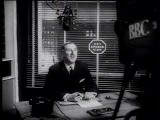 Video playback was particularly useful for the replay of sporting events such as horse racing, though good quality and immediate slow motion action replays had to wait for the invention of magnetic videodisc recording in 1968, and the replay time of these early disc recorders was limited to less than 30 seconds. Pictured here is the presenter of Sportsview, Peter Dimmock.
Video playback was particularly useful for the replay of sporting events such as horse racing, though good quality and immediate slow motion action replays had to wait for the invention of magnetic videodisc recording in 1968, and the replay time of these early disc recorders was limited to less than 30 seconds. Pictured here is the presenter of Sportsview, Peter Dimmock.
 Current affairs is a very important part of the schedule, and uses the medium of television to effectively cover the background to current news stories with a greater depth than is generally possible with a conventional news bulletin; here is Cliff Michelmore presenting an episode of Tonight. Other similar programmes include Panorama, which was (and still is) the BBC’s flagship current affairs programme that usually tackles a single topical issue in depth.
Current affairs is a very important part of the schedule, and uses the medium of television to effectively cover the background to current news stories with a greater depth than is generally possible with a conventional news bulletin; here is Cliff Michelmore presenting an episode of Tonight. Other similar programmes include Panorama, which was (and still is) the BBC’s flagship current affairs programme that usually tackles a single topical issue in depth.
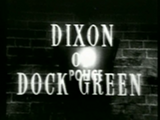 Dixon of Dock Green, with Jack Warner as PC Dixon was a long running police series that was rather old-fashioned in its approach even when it was first shown, but was popular nevertheless and lasted right up until 1976 when the competition (such as Z Cars and Softly Softly Task Force) started to make it look way past its “sell-by date”.
Dixon of Dock Green, with Jack Warner as PC Dixon was a long running police series that was rather old-fashioned in its approach even when it was first shown, but was popular nevertheless and lasted right up until 1976 when the competition (such as Z Cars and Softly Softly Task Force) started to make it look way past its “sell-by date”.
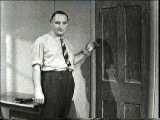 The increase in viewers combined with competition from ITV by 1955 lead to new programme ideas being explored. From 1956 onwards, Barry Bucknell (pictured here) presented do-it-yourself projects on television, firstly as a contributor to About The Home which was then followed by his own series, entitled Barry Bucknell’s Do It Yourself. Just like many contemporaneous studio-based productions, this was broadcast live, resulting in the occasional (and inevitable) on-screen mishap. He then went on to present the much more ambitious house renovation programme Bucknell’s House in 1962, featuring a house in Ealing bought for £2,250. This area of programming was relatively neglected during the following decades until the advent of Changing Rooms in 1994, though there was On the House shown in the mid 1980s.
The increase in viewers combined with competition from ITV by 1955 lead to new programme ideas being explored. From 1956 onwards, Barry Bucknell (pictured here) presented do-it-yourself projects on television, firstly as a contributor to About The Home which was then followed by his own series, entitled Barry Bucknell’s Do It Yourself. Just like many contemporaneous studio-based productions, this was broadcast live, resulting in the occasional (and inevitable) on-screen mishap. He then went on to present the much more ambitious house renovation programme Bucknell’s House in 1962, featuring a house in Ealing bought for £2,250. This area of programming was relatively neglected during the following decades until the advent of Changing Rooms in 1994, though there was On the House shown in the mid 1980s.
 Grandstand was the name of the BBC’s long-running sports magazine programme that was broadcast between 1958 and 2007, mainly on Saturday afternoons when much of the sporting action took place. Peter Dimmock presented the first three programmes but David Coleman then took over the role of presenter who was followed by Frank Bough, Des Lynam, Steve Rider and a slew of guest presenters during its final years up until Grandstand‘s final broadcasts during the last weekend of January 2007. It was most likely axed because the BBC now had fewer rights to broadcast sport than it did in the past due to increased competition from other broadcasters; notably pay-TV sport channels provided by broadcasters like BSkyB and BT.
Grandstand was the name of the BBC’s long-running sports magazine programme that was broadcast between 1958 and 2007, mainly on Saturday afternoons when much of the sporting action took place. Peter Dimmock presented the first three programmes but David Coleman then took over the role of presenter who was followed by Frank Bough, Des Lynam, Steve Rider and a slew of guest presenters during its final years up until Grandstand‘s final broadcasts during the last weekend of January 2007. It was most likely axed because the BBC now had fewer rights to broadcast sport than it did in the past due to increased competition from other broadcasters; notably pay-TV sport channels provided by broadcasters like BSkyB and BT.
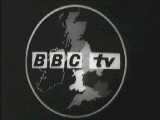

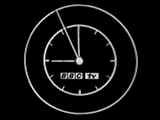 The above images illustrate the style of programme promotion used circa 1960, with its contemporary style and bold graphics replacing the Abram Games-designed “bat’s wings” symbol; elements of the new design had been introduced during 1959 prior to its formal introduction in 1960. Note the “BBC tv” italic letters appearing in separate square boxes similar to the modern BBC logo style, and the clock kept the unusually long second hand previously used for the “bat’s wing” clock. However this presentation style didn’t last nearly as long as the Abram Games symbol, with the introduction of the first of a succession of various globe symbols used to identify BBC Television soon to follow together with changes in style for the BBC corporate logo.
The above images illustrate the style of programme promotion used circa 1960, with its contemporary style and bold graphics replacing the Abram Games-designed “bat’s wings” symbol; elements of the new design had been introduced during 1959 prior to its formal introduction in 1960. Note the “BBC tv” italic letters appearing in separate square boxes similar to the modern BBC logo style, and the clock kept the unusually long second hand previously used for the “bat’s wing” clock. However this presentation style didn’t last nearly as long as the Abram Games symbol, with the introduction of the first of a succession of various globe symbols used to identify BBC Television soon to follow together with changes in style for the BBC corporate logo.
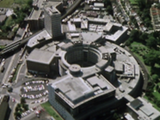 With television now rapidly becoming the dominant broadcasting medium in the UK, the BBC needed somewhere that was much bigger than Alexandra Palace to accommodate its production requirements, therefore a new headquarters known as BBC Television Centre was commissioned and built on a suitable site in West London, with construction commencing in 1952 and Television Centre was ready for use by June 1960. From the air, the Television Centre buildings appear to take on the shape of a question mark, because that layout was thought to be best for the site in general.
With television now rapidly becoming the dominant broadcasting medium in the UK, the BBC needed somewhere that was much bigger than Alexandra Palace to accommodate its production requirements, therefore a new headquarters known as BBC Television Centre was commissioned and built on a suitable site in West London, with construction commencing in 1952 and Television Centre was ready for use by June 1960. From the air, the Television Centre buildings appear to take on the shape of a question mark, because that layout was thought to be best for the site in general.
 The BBC naturally wanted to show off its new Television Centre building to its viewers, so a special light entertainment programme was shown on 29 June 1960 in order to do just that, logically entitled First Night. Not all of the BBC’s departments moved into the new building straightaway, with (for example) the News division not moving into Television Centre until 1969. The Open University was to make use of otherwise-unused Alexandra Palace studio facilities from 1970 onwards.
The BBC naturally wanted to show off its new Television Centre building to its viewers, so a special light entertainment programme was shown on 29 June 1960 in order to do just that, logically entitled First Night. Not all of the BBC’s departments moved into the new building straightaway, with (for example) the News division not moving into Television Centre until 1969. The Open University was to make use of otherwise-unused Alexandra Palace studio facilities from 1970 onwards.


The 1963 Eurovision Song Contest came from London due to the United Kingdom winning the previous year’s contest, giving the BBC an opportunity to show off its still relatively new Television Centre headquarters to a much bigger Eurovision audience worldwide.
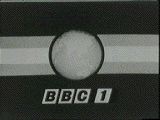 The introduction of BBC2 in 1964, which enabled extra programmes which were not necessarily of mass appeal to be shown, and eventually colour was introduced to (what was now known as) BBC1 by the end of the decade. Some very memorable and ground-breaking programmes were being produced during this period which are still being shown around the world today, such as Steptoe and Son, and the long-running Doctor Who series began. Other programmes shown during the late 1960s included the popular sitcom Beggar My Neighbour, soap The Newcomers and football club drama United.
The introduction of BBC2 in 1964, which enabled extra programmes which were not necessarily of mass appeal to be shown, and eventually colour was introduced to (what was now known as) BBC1 by the end of the decade. Some very memorable and ground-breaking programmes were being produced during this period which are still being shown around the world today, such as Steptoe and Son, and the long-running Doctor Who series began. Other programmes shown during the late 1960s included the popular sitcom Beggar My Neighbour, soap The Newcomers and football club drama United.
 The weather forecast had progressed from the use of hand-drawn maps to the use of magnetic symbols by the mid-1960s as shown here, and this style of map continued to be used for several years after BBC1 had started broadcasting in colour in 1969. Before the use of magnetic symbols, everything had to be hand-drawn which was a time-consuming practice as well as being rather inflexible; the whole map obviously had to be redrawn if a correction was required.
The weather forecast had progressed from the use of hand-drawn maps to the use of magnetic symbols by the mid-1960s as shown here, and this style of map continued to be used for several years after BBC1 had started broadcasting in colour in 1969. Before the use of magnetic symbols, everything had to be hand-drawn which was a time-consuming practice as well as being rather inflexible; the whole map obviously had to be redrawn if a correction was required.
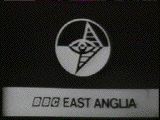 Despite BBC1 getting the go-ahead to start a colour service in 1969, the regional centres were inevitably slower to upgrade all of their equipment to provide a colour service due to cost reasons, and it was several months before Television Centre was fully colour-equipped. The news magazine programme Nationwide incorporating reports and features from the various regions also started in this particular year, and some of the regional contributions weren’t produced in colour until the end of the 1970s. (Inside Out is perhaps the modern spiritual successor to Nationwide even if The One Show has a similar mix of features and studio discussion pieces.)
Despite BBC1 getting the go-ahead to start a colour service in 1969, the regional centres were inevitably slower to upgrade all of their equipment to provide a colour service due to cost reasons, and it was several months before Television Centre was fully colour-equipped. The news magazine programme Nationwide incorporating reports and features from the various regions also started in this particular year, and some of the regional contributions weren’t produced in colour until the end of the 1970s. (Inside Out is perhaps the modern spiritual successor to Nationwide even if The One Show has a similar mix of features and studio discussion pieces.)
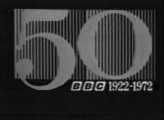 1972 was the 50th anniversary of the BBC, though at that time less than 20% of viewers had a colour television despite a colour service being available on all three channels since 1969; the BBC’s summer Olympic Games coverage did however help to boost colour television sales during 1972. Notable BBC1 programmes broadcast during the early 1970s included Bruce Forsyth and the Generation Game (its initial title) which started in 1971, science fiction drama Moonbase 3, drama series Owen, M.D., plus the popular sitcoms Are You Being Served? and the very long-running Last Of The Summer Wine began in 1972.
1972 was the 50th anniversary of the BBC, though at that time less than 20% of viewers had a colour television despite a colour service being available on all three channels since 1969; the BBC’s summer Olympic Games coverage did however help to boost colour television sales during 1972. Notable BBC1 programmes broadcast during the early 1970s included Bruce Forsyth and the Generation Game (its initial title) which started in 1971, science fiction drama Moonbase 3, drama series Owen, M.D., plus the popular sitcoms Are You Being Served? and the very long-running Last Of The Summer Wine began in 1972.
 By the mid 1970s most families had at least one television set, and nearly all of the populated regions of the British Isles could receive television pictures in some form even if it was only a 405-line monochrome signal. Sitcoms and studio-based light entertainment were of extremely high quality during this period, with many classic programmes produced including It Ain’t Half Hot Mum, Some Mothers Do ‘Ave ‘Em, The Good Life and The Liver Birds. The Two Ronnies, The Morecambe and Wise Show and The Mike Yarwood Show featured in what many people now consider to be the BBC’s greatest ever Christmas Day schedule in 1977.
By the mid 1970s most families had at least one television set, and nearly all of the populated regions of the British Isles could receive television pictures in some form even if it was only a 405-line monochrome signal. Sitcoms and studio-based light entertainment were of extremely high quality during this period, with many classic programmes produced including It Ain’t Half Hot Mum, Some Mothers Do ‘Ave ‘Em, The Good Life and The Liver Birds. The Two Ronnies, The Morecambe and Wise Show and The Mike Yarwood Show featured in what many people now consider to be the BBC’s greatest ever Christmas Day schedule in 1977.
First given a public demonstration in 1972, the BBC-developed CEEFAX information service commenced public transmissions in September 1974 though it wasn’t until 1976 when suitable set-top boxes for the service were available to buy in any quantity.
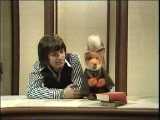 The Basil Brush Show started life as a children’s programme in 1968, showing on Thursdays just before the early evening news, but by the mid-1970s it had moved to an early Saturday evening slot and was now a very popular mainstream family entertainment show, featuring top singing stars like Cilla Black, Demis Roussos and Petula Clark that often did a comedy duet with fox puppet Basil as well as singing on their own. Basil is shown here with Roy North, who became Basil’s human sidekick in 1976.
The Basil Brush Show started life as a children’s programme in 1968, showing on Thursdays just before the early evening news, but by the mid-1970s it had moved to an early Saturday evening slot and was now a very popular mainstream family entertainment show, featuring top singing stars like Cilla Black, Demis Roussos and Petula Clark that often did a comedy duet with fox puppet Basil as well as singing on their own. Basil is shown here with Roy North, who became Basil’s human sidekick in 1976.
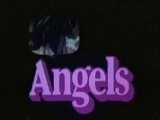 Angels was a popular drama series set in a fictional (St. Angela’s) hospital, and is just one example of the BBC’s prodigious drama output from the 1970s. Indeed Angels survived until the early 1980s and was the spiritual predecessor to Casualty (which started in 1986) and its later spin-off Holby City which are now shown on a regular basis. Other drama offerings from this period included historical drama I, Claudius, and science fiction series Blake’s 7 began in 1978.
Angels was a popular drama series set in a fictional (St. Angela’s) hospital, and is just one example of the BBC’s prodigious drama output from the 1970s. Indeed Angels survived until the early 1980s and was the spiritual predecessor to Casualty (which started in 1986) and its later spin-off Holby City which are now shown on a regular basis. Other drama offerings from this period included historical drama I, Claudius, and science fiction series Blake’s 7 began in 1978.

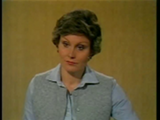
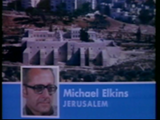
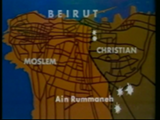 Pictured is what a typical BBC News bulletin looked like in 1978, with Angela Rippon being the newsreader. There was still a predominance of photographs used during this period as opposed to the video clips that typify modern news bulletins, though national news bulletins were steadily becoming more sophisticated in their visual presentation.
Pictured is what a typical BBC News bulletin looked like in 1978, with Angela Rippon being the newsreader. There was still a predominance of photographs used during this period as opposed to the video clips that typify modern news bulletins, though national news bulletins were steadily becoming more sophisticated in their visual presentation.
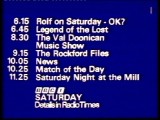 Here’s an example of a BBC1 Saturday evening programme schedule as broadcast on 14 April 1979. At this point virtually all new programmes were now being produced in colour, though there were still a significant number of people that didn’t have colour televisions; 1976 being the year when colour TV licences outnumbered those issued for black and white. 1979 also saw the broadcast of what was the most ambitious natural history series commissioned up to that point, namely Life on Earth, presented by David Attenborough.
Here’s an example of a BBC1 Saturday evening programme schedule as broadcast on 14 April 1979. At this point virtually all new programmes were now being produced in colour, though there were still a significant number of people that didn’t have colour televisions; 1976 being the year when colour TV licences outnumbered those issued for black and white. 1979 also saw the broadcast of what was the most ambitious natural history series commissioned up to that point, namely Life on Earth, presented by David Attenborough.
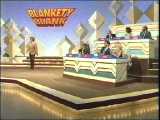 Blankety Blank was a popular BBC quiz show which was first presented by Terry Wogan (famous for having his long stick microphone bent by Kenny Everett), but was later presented by Les Dawson. Then the series was revived with Lilly Savage at the helm, followed by ITV giving the idea a brief revival itself but none of these revivals matched the popularity of the original series.
Blankety Blank was a popular BBC quiz show which was first presented by Terry Wogan (famous for having his long stick microphone bent by Kenny Everett), but was later presented by Les Dawson. Then the series was revived with Lilly Savage at the helm, followed by ITV giving the idea a brief revival itself but none of these revivals matched the popularity of the original series.
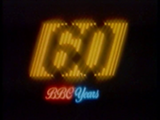 1982 was the 60th anniversary of the BBC, and the “60 BBC Years” slogan was also used at the bottom of the BBC1 globe ident for a while as part of the celebrations. September that same year also saw the introduction of a new light entertainment series: The Late, Late Breakfast Show, which featured a selection of occasionally dangerous stunts performed by members of the public in the “Give It A Whirl” slot that resulted in several injuries and a death that caused the show to be cancelled in 1986. The Late-Late Breakfast Show was presented by Noel Edmonds who at that point was famous for presenting breakfast shows both on the radio and Swap Shop on BBC1, hence the tongue-in-cheek title.
1982 was the 60th anniversary of the BBC, and the “60 BBC Years” slogan was also used at the bottom of the BBC1 globe ident for a while as part of the celebrations. September that same year also saw the introduction of a new light entertainment series: The Late, Late Breakfast Show, which featured a selection of occasionally dangerous stunts performed by members of the public in the “Give It A Whirl” slot that resulted in several injuries and a death that caused the show to be cancelled in 1986. The Late-Late Breakfast Show was presented by Noel Edmonds who at that point was famous for presenting breakfast shows both on the radio and Swap Shop on BBC1, hence the tongue-in-cheek title.
 1982 was also the year of the Falklands War, with the BBC naturally devoting significant coverage to this particular news story allowing for the limitations of war reporting. Also the raising of the wreck of the Mary Rose was shown live on television in the same year.
1982 was also the year of the Falklands War, with the BBC naturally devoting significant coverage to this particular news story allowing for the limitations of war reporting. Also the raising of the wreck of the Mary Rose was shown live on television in the same year.
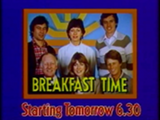 The start of 1983 heralded the launch of breakfast television, with the BBC getting in first with their Breakfast Time before the new TV-am ITV franchise started over on Channel 3. Frank Bough and the team turned out to be just what the nation was waiting for in terms of breakfast television in the morning, and the new TV-am got off to a bad start to the day as a consequence.
The start of 1983 heralded the launch of breakfast television, with the BBC getting in first with their Breakfast Time before the new TV-am ITV franchise started over on Channel 3. Frank Bough and the team turned out to be just what the nation was waiting for in terms of breakfast television in the morning, and the new TV-am got off to a bad start to the day as a consequence.
 By January 1985 the old 405-line VHF network had completely closed down, and a full daytime television schedule launched in 1986 that included Neighbours, the Australian soap opera which is still being shown on Channel 5. By 1989 the BBC and other broadcasters also faced competition from the newly-emerging satellite services (Sky and BSB, with Sky eventually taking over BSB to form BSkyB). Pictured is an example of what a Saturday evening’s viewing on BBC1 looked like on the 6th of June 1987.
By January 1985 the old 405-line VHF network had completely closed down, and a full daytime television schedule launched in 1986 that included Neighbours, the Australian soap opera which is still being shown on Channel 5. By 1989 the BBC and other broadcasters also faced competition from the newly-emerging satellite services (Sky and BSB, with Sky eventually taking over BSB to form BSkyB). Pictured is an example of what a Saturday evening’s viewing on BBC1 looked like on the 6th of June 1987.
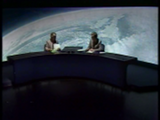


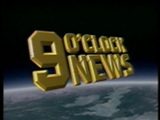 This graphic style used for BBC News has the nickname of “Star Wars” due to the logo appearing to be constructed in space using a beam of light; it certainly seemed to match the mood of the period in terms of its drama and pomposity.
This graphic style used for BBC News has the nickname of “Star Wars” due to the logo appearing to be constructed in space using a beam of light; it certainly seemed to match the mood of the period in terms of its drama and pomposity.
 The 1980s was also the era of the video cassette recorder or ‘VCR’; although such devices were available in the 1970s (and earlier) it was this decade that saw them become widely available and (by 1987) inexpensive thanks to the aggressive pricing of Far Eastern-produced machines such as Amstrad. Teletext became commonplace on more expensive sets and included on some of the cheaper ones too, and Nicam stereo sound was introduced towards the end of the decade, initially from certain transmitters only.
The 1980s was also the era of the video cassette recorder or ‘VCR’; although such devices were available in the 1970s (and earlier) it was this decade that saw them become widely available and (by 1987) inexpensive thanks to the aggressive pricing of Far Eastern-produced machines such as Amstrad. Teletext became commonplace on more expensive sets and included on some of the cheaper ones too, and Nicam stereo sound was introduced towards the end of the decade, initially from certain transmitters only.
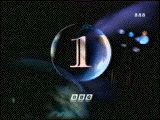 All smoke and mirrors? The globe above was replaced with this smoky light reflecting version in 1991, together with the return of the 1960s typeface. The word ‘Stereo’ appeared in the top-left hand corner when a programme with a stereo soundtrack followed – BBC1 was the last established UK channel to formally introduce Nicam stereo, which it did in September 1991, but not all major transmitters had been upgraded to carry the digital signal from day one.
All smoke and mirrors? The globe above was replaced with this smoky light reflecting version in 1991, together with the return of the 1960s typeface. The word ‘Stereo’ appeared in the top-left hand corner when a programme with a stereo soundtrack followed – BBC1 was the last established UK channel to formally introduce Nicam stereo, which it did in September 1991, but not all major transmitters had been upgraded to carry the digital signal from day one.
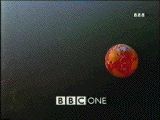 The change from a globe to a balloon (albeit with a globe pattern) came at the same time as the BBC changed its onscreen font to Gill Sans in October 1997, which was part of Martin Lambie-Nairn’s corporate vision for the BBC. The adoption of Gill Sans was something that was both traditional and forward-thinking in terms of looking better when displayed in the new widescreen format and when decompressed from a digitally-compressed datastream compared with the old sloping rhombus typeface that dates back to the 1960s. A variety of short video clips are used featuring the BBC balloon in different locations around the British Isles (above a castle, behind a suspension bridge, etc.), meaning that the balloon usually had a different ‘view’ before each programme as opposed to the essentially static backdrop that the globe had.
The change from a globe to a balloon (albeit with a globe pattern) came at the same time as the BBC changed its onscreen font to Gill Sans in October 1997, which was part of Martin Lambie-Nairn’s corporate vision for the BBC. The adoption of Gill Sans was something that was both traditional and forward-thinking in terms of looking better when displayed in the new widescreen format and when decompressed from a digitally-compressed datastream compared with the old sloping rhombus typeface that dates back to the 1960s. A variety of short video clips are used featuring the BBC balloon in different locations around the British Isles (above a castle, behind a suspension bridge, etc.), meaning that the balloon usually had a different ‘view’ before each programme as opposed to the essentially static backdrop that the globe had.


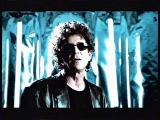
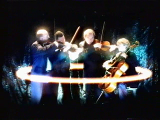
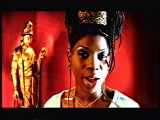


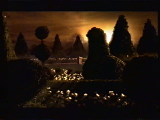
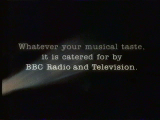 Also launched at the same time as the new corporate look for the BBC was perhaps the most successful UK TV-based promotion of all time; it was based around a simple concept, namely that the BBC offers a huge variety of different types of music, catering for almost every taste on its numerous radio and television services.
Also launched at the same time as the new corporate look for the BBC was perhaps the most successful UK TV-based promotion of all time; it was based around a simple concept, namely that the BBC offers a huge variety of different types of music, catering for almost every taste on its numerous radio and television services.
 Set to the soundtrack of Perfect Day, a song originally performed by Lou Reed who also appears amongst the numerous celebrities who both take it in turns to sing and appear on screen, with a slide projector showing various images interspersed with the celebrities. Also note the thin black bars appearing at the top and bottom of the pictures, indicating that it was one of the first BBC productions to be produced in widescreen format, though the widescreen format was only formally introduced with the introduction of digital widescreen broadcasting the following year.
Set to the soundtrack of Perfect Day, a song originally performed by Lou Reed who also appears amongst the numerous celebrities who both take it in turns to sing and appear on screen, with a slide projector showing various images interspersed with the celebrities. Also note the thin black bars appearing at the top and bottom of the pictures, indicating that it was one of the first BBC productions to be produced in widescreen format, though the widescreen format was only formally introduced with the introduction of digital widescreen broadcasting the following year.
 This version of Perfect Day was released as a charity record and sold more than a million copies in the UK, reaching Number 1 in the singles chart and most likely to have been a major factor in the popularity of this particular promotion, though it has to be said that the promotion itself was exquisitely produced and directed therefore is essentially a work of art in its own right.
This version of Perfect Day was released as a charity record and sold more than a million copies in the UK, reaching Number 1 in the singles chart and most likely to have been a major factor in the popularity of this particular promotion, though it has to be said that the promotion itself was exquisitely produced and directed therefore is essentially a work of art in its own right.
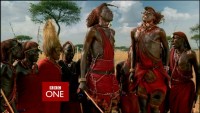 March 2002 saw a radical new look introduced for BBC One; the main channel logo now appears in a box just like the BBC Two logo, but more controversially the globe as a centrepiece has now been banished to the history books, and instead various sequences using dance as a theme have been introduced. The whole emphasis was to introduce a modern multicultural ‘feel’ to the channel, but whether the identity of the channel had been diluted as a result is open to debate, especially as the channel’s presentation package only lasted four years before being replaced by something else.
March 2002 saw a radical new look introduced for BBC One; the main channel logo now appears in a box just like the BBC Two logo, but more controversially the globe as a centrepiece has now been banished to the history books, and instead various sequences using dance as a theme have been introduced. The whole emphasis was to introduce a modern multicultural ‘feel’ to the channel, but whether the identity of the channel had been diluted as a result is open to debate, especially as the channel’s presentation package only lasted four years before being replaced by something else.
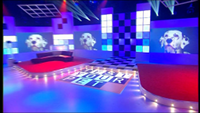 Several programming ideas were tried in 2004 with mixed results; Test your Pet, presumably intended to be educational in relation to animal training but ended up being closer in spirit to to the somewhat infamous but fun Pets Win Prizes. As well as testing pets, humans were equally tested in Come and Have a Go… If You Think You’re Smart Enough, consumer issues were aired in the short-lived Brassed Off Britain, detective drama Murphy’s Law received an airing but something rather more enduring also debuted soon afterwards – Strictly Come Dancing, a dance competition show which rapidly became very popular and continues to this day. And the following year saw the rejuvenation of an old idea which also proved to be just as popular.
Several programming ideas were tried in 2004 with mixed results; Test your Pet, presumably intended to be educational in relation to animal training but ended up being closer in spirit to to the somewhat infamous but fun Pets Win Prizes. As well as testing pets, humans were equally tested in Come and Have a Go… If You Think You’re Smart Enough, consumer issues were aired in the short-lived Brassed Off Britain, detective drama Murphy’s Law received an airing but something rather more enduring also debuted soon afterwards – Strictly Come Dancing, a dance competition show which rapidly became very popular and continues to this day. And the following year saw the rejuvenation of an old idea which also proved to be just as popular.
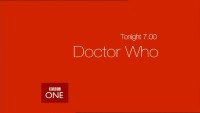 By 2005 Lorraine Heggessey had been replaced by Peter Fincham as controller of BBC One, and the general consensus was that Heggessey had left the channel in a relatively strong position in terms of its drama output with a newly rejuvenated Doctor Who alongside other popular series like New Tricks, proving that it is still possible to have a drama series that appeals to the whole family, though the channel was criticised in the BBC Annual Report for perhaps running too many repeats in peak time. Hustle and A Picture of Britain were other examples of popular programmes, plus The Kumars at No 42 being an example of a programme transferred from BBC Two to BBC One.
By 2005 Lorraine Heggessey had been replaced by Peter Fincham as controller of BBC One, and the general consensus was that Heggessey had left the channel in a relatively strong position in terms of its drama output with a newly rejuvenated Doctor Who alongside other popular series like New Tricks, proving that it is still possible to have a drama series that appeals to the whole family, though the channel was criticised in the BBC Annual Report for perhaps running too many repeats in peak time. Hustle and A Picture of Britain were other examples of popular programmes, plus The Kumars at No 42 being an example of a programme transferred from BBC Two to BBC One.
 August 2006 saw the first four week trial run of The ONE Show, but its debut had notable differences compared to what the series became when it returned as an (almost) regular fixture of early weekday evenings on BBC One starting from July 2007, notably a different co-presenter alongside Adrian Chiles (Nadia Sawalha), plus a different title sequence with different music as well as the studio being based in Birmingham (the studio overlooked a canal).
August 2006 saw the first four week trial run of The ONE Show, but its debut had notable differences compared to what the series became when it returned as an (almost) regular fixture of early weekday evenings on BBC One starting from July 2007, notably a different co-presenter alongside Adrian Chiles (Nadia Sawalha), plus a different title sequence with different music as well as the studio being based in Birmingham (the studio overlooked a canal).
 During the 2006 trial there was a more formal use of a map showing different UK locations where each regional feature originated from. The ONE Show was thought of by some people as being a spiritual successor to Nationwide, but this was perhaps more the case for the trial run with its map-based presentation as opposed to the revamped final version which had essentially become just a succession of studio-linked features.
During the 2006 trial there was a more formal use of a map showing different UK locations where each regional feature originated from. The ONE Show was thought of by some people as being a spiritual successor to Nationwide, but this was perhaps more the case for the trial run with its map-based presentation as opposed to the revamped final version which had essentially become just a succession of studio-linked features.
 The ONE Show‘s trial run was judged to have been a success but several changes were made including the moderately controversial step of moving the show’s studio base to London as well as employing Christine Bleakley as a co-presenter since Sawalha was no longer available, though both Chiles and Bleakley were later lured by ITV in order to head up their new GMTV replacement, Daybreak, but that didn’t work out as expected therefore both are now employed on different projects within ITV productions. (Chiles was and still is noted for his football punditry.)
The ONE Show‘s trial run was judged to have been a success but several changes were made including the moderately controversial step of moving the show’s studio base to London as well as employing Christine Bleakley as a co-presenter since Sawalha was no longer available, though both Chiles and Bleakley were later lured by ITV in order to head up their new GMTV replacement, Daybreak, but that didn’t work out as expected therefore both are now employed on different projects within ITV productions. (Chiles was and still is noted for his football punditry.)
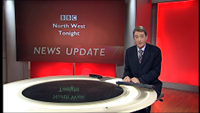 Also included immediately after The ONE Show during its 2006 trial was a short regional news opt-out billed as an “news update”; illustrated here is the BBC North West Tonight News Update, presented by Gordon Burns who has now retired and been replaced by Roger Johnson (ex-BBC South Today).
Also included immediately after The ONE Show during its 2006 trial was a short regional news opt-out billed as an “news update”; illustrated here is the BBC North West Tonight News Update, presented by Gordon Burns who has now retired and been replaced by Roger Johnson (ex-BBC South Today).
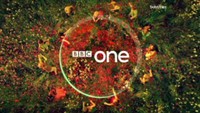 What comes around…The dance and movement idents were inevitably replaced by new idents in 2006, and Red Bee Media had been contracted to produce their replacement. For inspiration they looked at some of the early 1950s BBC Television Service idents which inevitably used some form of circle as part of a tuning signal for viewers to adjust their TV sets, and everything from the Abram Games “bat’s wing” symbol to the later globes also featured a circle as part of their design, so Red Bee proposed that a new identity theme should be based around the concept of circles. New idents were produced which featured real life circular elements such as hippos, surfers, dancing children and the moon, plus the channel logo was given a new and bolder treatment. A circle signifies ‘togetherness’ in the eyes of the branding consultants, but whether viewers actually made the connection remained to be seen.
What comes around…The dance and movement idents were inevitably replaced by new idents in 2006, and Red Bee Media had been contracted to produce their replacement. For inspiration they looked at some of the early 1950s BBC Television Service idents which inevitably used some form of circle as part of a tuning signal for viewers to adjust their TV sets, and everything from the Abram Games “bat’s wing” symbol to the later globes also featured a circle as part of their design, so Red Bee proposed that a new identity theme should be based around the concept of circles. New idents were produced which featured real life circular elements such as hippos, surfers, dancing children and the moon, plus the channel logo was given a new and bolder treatment. A circle signifies ‘togetherness’ in the eyes of the branding consultants, but whether viewers actually made the connection remained to be seen.
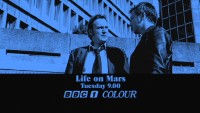 The second series of the critically-acclaimed drama Life On Mars (about a policeman who thinks that he’s living in 1973) was shown on BBC One and repeated on BBC Four during February and March of 2007. Red Bee Media was given the contract to produce promotional material for this series, and the end result was an imaginative collection of various items such as bus shelter posters and promotional clips which had been given a retro 1970s-style treatment.
The second series of the critically-acclaimed drama Life On Mars (about a policeman who thinks that he’s living in 1973) was shown on BBC One and repeated on BBC Four during February and March of 2007. Red Bee Media was given the contract to produce promotional material for this series, and the end result was an imaginative collection of various items such as bus shelter posters and promotional clips which had been given a retro 1970s-style treatment.
 Plus each episode of Life On Mars on BBC One began with a widescreen recreation of the style of globe ident that was in use during this era, whilst viewers in Wales were treated to a different, genuine mechanical globe complete with a voiceover provided by a continuity announcer who had worked during the early-’70s period. (Though BBC Wales didn’t actually use this type of globe until 1974.)
Plus each episode of Life On Mars on BBC One began with a widescreen recreation of the style of globe ident that was in use during this era, whilst viewers in Wales were treated to a different, genuine mechanical globe complete with a voiceover provided by a continuity announcer who had worked during the early-’70s period. (Though BBC Wales didn’t actually use this type of globe until 1974.)
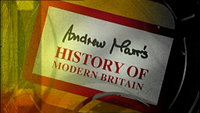 Other BBC One programmes in 2007 included the rather ambitious series Andrew Marr’s History of Modern Britain which attempted to cover a huge subject in five programmes broadcast between 22 May and 19 June, and its critical success resulted in a follow-up series entitled Andrew Marr’s The Making of Modern Britain.
Other BBC One programmes in 2007 included the rather ambitious series Andrew Marr’s History of Modern Britain which attempted to cover a huge subject in five programmes broadcast between 22 May and 19 June, and its critical success resulted in a follow-up series entitled Andrew Marr’s The Making of Modern Britain.
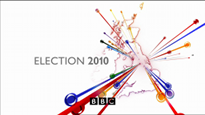 2010 saw a General Election in which a coalition government was returned, given no overall majority in the House of Commons. The BBC was on-hand to provide its comprehensive results service as is normal for such occasions, with its BBC News channel also providing rolling coverage once the main programme had drawn to a close.
2010 saw a General Election in which a coalition government was returned, given no overall majority in the House of Commons. The BBC was on-hand to provide its comprehensive results service as is normal for such occasions, with its BBC News channel also providing rolling coverage once the main programme had drawn to a close.
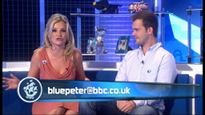 The first major department to move from London’s Television Centre to MediaCityUK in Salford Quays was children’s television, with the Blue Peter garden following Blue Peter to its new Salford home and is now a rooftop garden. This picture is taken from the very first Blue Peter to be broadcast from Salford, with the two regular presenters arriving via dramatic means – Helen Skelton by helicopter and Barney Harwood by jet ski.
The first major department to move from London’s Television Centre to MediaCityUK in Salford Quays was children’s television, with the Blue Peter garden following Blue Peter to its new Salford home and is now a rooftop garden. This picture is taken from the very first Blue Peter to be broadcast from Salford, with the two regular presenters arriving via dramatic means – Helen Skelton by helicopter and Barney Harwood by jet ski.


And finally…BBC North West Tonight was the last department to move out of Broadcasting House in Oxford Street, relocating to its new home in the BBC’s new MediaCityUK complex at nearby Salford, and is now based alongside the BBC’s children’s TV and sport departments (amongst others) that had already relocated there from London. Manchester’s Broadcasting House was opened in July 1976 and had formerly been the home for everything from Mark and Lard to Life On Mars over the years. Demolition of Broadcasting House commenced in August 2012 and had been completed by the end of March 2013.
 2012 was certainly a busy year for the BBC in terms of large public events; firstly there was the Queen’s Diamond Jubilee with its associated river pageant and concert to cover as well as the London Olympic Games later in the year. The BBC’s coverage of the pageant was, however, not one of its finest moments due to several technical problems meaning that many of the planned live links with boats taking part in the pageant had to be cancelled, inevitably resulting in land-based presenters such as Fearne Cotton being left with the task of filling in much more frequently than originally intended.
2012 was certainly a busy year for the BBC in terms of large public events; firstly there was the Queen’s Diamond Jubilee with its associated river pageant and concert to cover as well as the London Olympic Games later in the year. The BBC’s coverage of the pageant was, however, not one of its finest moments due to several technical problems meaning that many of the planned live links with boats taking part in the pageant had to be cancelled, inevitably resulting in land-based presenters such as Fearne Cotton being left with the task of filling in much more frequently than originally intended.
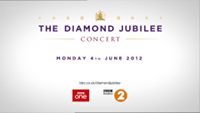 Thankfully the BBC’s coverage of the Diamond Jubilee concert went much more smoothly, even if there were a few complaints about concert sound quality from some viewers. Various big-name acts took to the stage, including Stevie Wonder, Annie Lennox, Robbie Williams, Tom Jones, Sir Cliff Richard, Grace Jones doing a highly memorable routine with a hula hoop to Slave to the Rhythm, and Madness performing on top of Buckingham Palace whilst various images were being projected on the front of the building. The end result was a concert which was watched by an average of nearly 15 million viewers.
Thankfully the BBC’s coverage of the Diamond Jubilee concert went much more smoothly, even if there were a few complaints about concert sound quality from some viewers. Various big-name acts took to the stage, including Stevie Wonder, Annie Lennox, Robbie Williams, Tom Jones, Sir Cliff Richard, Grace Jones doing a highly memorable routine with a hula hoop to Slave to the Rhythm, and Madness performing on top of Buckingham Palace whilst various images were being projected on the front of the building. The end result was a concert which was watched by an average of nearly 15 million viewers.
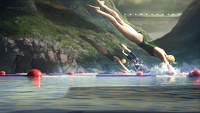

 Once in a lifetime…The London 2012 Olympic Games promised the biggest sporting spectacle the UK had ever seen, therefore it was the BBC’s obligation to provide the best and most comprehensive coverage possible for its viewers. Indeed the BBC devoted a very significant chunk of its resources to the Games as a consequence, which included an extra HD TV channel for digital terrestrial (Freeview) viewers, 30 additional HD channels for viewing via satellite, cable or online plus other radio and online resources. It wasn’t surprising therefore that an elaborate animated promotion was commissioned to promote the BBC’s wide-ranging coverage of such a major event.
Once in a lifetime…The London 2012 Olympic Games promised the biggest sporting spectacle the UK had ever seen, therefore it was the BBC’s obligation to provide the best and most comprehensive coverage possible for its viewers. Indeed the BBC devoted a very significant chunk of its resources to the Games as a consequence, which included an extra HD TV channel for digital terrestrial (Freeview) viewers, 30 additional HD channels for viewing via satellite, cable or online plus other radio and online resources. It wasn’t surprising therefore that an elaborate animated promotion was commissioned to promote the BBC’s wide-ranging coverage of such a major event.
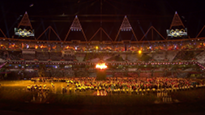 Shown on BBC1, BBC One HD and also on the BBC HD channel in 3D, the London 2012 Olympics Opening Ceremony was watched by a peak of 27 million viewers; that’s roughly half the population of the UK tuning in to watch at least some of the ceremony’s live coverage. Danny Boyle was responsible for producing and directing the ceremony’s elaborate routines, set design and special effects that culminated in the lighting of the Olympic cauldron by eight promising young athletes using the Olympic torch that had previously been carried around the UK by various selected individuals over the previous weeks.
Shown on BBC1, BBC One HD and also on the BBC HD channel in 3D, the London 2012 Olympics Opening Ceremony was watched by a peak of 27 million viewers; that’s roughly half the population of the UK tuning in to watch at least some of the ceremony’s live coverage. Danny Boyle was responsible for producing and directing the ceremony’s elaborate routines, set design and special effects that culminated in the lighting of the Olympic cauldron by eight promising young athletes using the Olympic torch that had previously been carried around the UK by various selected individuals over the previous weeks.
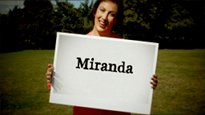 Despite recent distractions such as the aforementioned Olympics and Diamond Jubilee as well as the upheaval of moving staff and equipment out of Television Centre prior to its redevelopment, BBC One as a channel has continued to be a strong performer in terms of popular entertainment, factual programming, drama and comedy, with shows such as Strictly Come Dancing, Frozen Planet, Africa and Call the Midwife all attracting attention, with Miranda, Mrs Brown’s Boys and Outnumbered being three of the most popular comedies produced by the BBC in recent years. (Mrs Brown’s Boys is actually a co-production with Irish broadcaster RTÉ, who gets to broadcast each episode before the BBC does.)
Despite recent distractions such as the aforementioned Olympics and Diamond Jubilee as well as the upheaval of moving staff and equipment out of Television Centre prior to its redevelopment, BBC One as a channel has continued to be a strong performer in terms of popular entertainment, factual programming, drama and comedy, with shows such as Strictly Come Dancing, Frozen Planet, Africa and Call the Midwife all attracting attention, with Miranda, Mrs Brown’s Boys and Outnumbered being three of the most popular comedies produced by the BBC in recent years. (Mrs Brown’s Boys is actually a co-production with Irish broadcaster RTÉ, who gets to broadcast each episode before the BBC does.)
 Another important event for the BBC happened on 21 December 2012, which was the very last occasion when CBBC programmes were broadcast in a block on BBC One. Showing selected children’s television programmes on BBC One in the future isn’t out of the question, and there were plans to show series such as Horrible Histories in a teatime slot where they can be appreciated by a family audience as opposed to the (predominantly) children (and their parents) audience of the CBBC and CBeebies channels. Childrens’ television has perhaps been changed the most radically by the digital TV revolution, namely that many parents quickly opted to choose dedicated childrens’ TV channels for their children to watch when given the choice to do so.
Another important event for the BBC happened on 21 December 2012, which was the very last occasion when CBBC programmes were broadcast in a block on BBC One. Showing selected children’s television programmes on BBC One in the future isn’t out of the question, and there were plans to show series such as Horrible Histories in a teatime slot where they can be appreciated by a family audience as opposed to the (predominantly) children (and their parents) audience of the CBBC and CBeebies channels. Childrens’ television has perhaps been changed the most radically by the digital TV revolution, namely that many parents quickly opted to choose dedicated childrens’ TV channels for their children to watch when given the choice to do so.

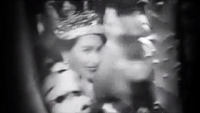
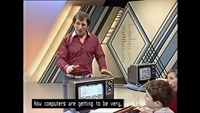
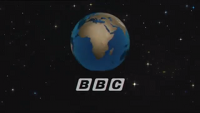 Where next…2012 also saw the BBC on the receiving end of some bad publicity in relation to the alleged antics of a now-deceased DJ and TV presenter Jimmy Savile, with some people thinking that BBC management at the time had some knowledge of Savile’s behind-the-scenes misbehaviour even though it’s almost certain that management at the time knew relatively little (if anything) as to what really happened, as well as most of his lewd behaviour occurring outside of BBC premises. Anyway, this breaking news story subsequently led to two misreporting mishaps primarily involving the BBC’s Newsnight current affairs programme that were most likely caused by major staff changes made in short succession leading to mistakes being made, but these incidents did somewhat tarnish the BBC’s reputation for scrupulously accurate current affairs reporting as a consequence, hence something was clearly needed to act as a PR offensive in order to repair the damage.
Where next…2012 also saw the BBC on the receiving end of some bad publicity in relation to the alleged antics of a now-deceased DJ and TV presenter Jimmy Savile, with some people thinking that BBC management at the time had some knowledge of Savile’s behind-the-scenes misbehaviour even though it’s almost certain that management at the time knew relatively little (if anything) as to what really happened, as well as most of his lewd behaviour occurring outside of BBC premises. Anyway, this breaking news story subsequently led to two misreporting mishaps primarily involving the BBC’s Newsnight current affairs programme that were most likely caused by major staff changes made in short succession leading to mistakes being made, but these incidents did somewhat tarnish the BBC’s reputation for scrupulously accurate current affairs reporting as a consequence, hence something was clearly needed to act as a PR offensive in order to repair the damage.
 Visually impressive in its design and scope, “Where Next?” sets out to remind the BBC’s viewers of all the good things the BBC has done over the years in terms of both programming and innovative firsts, starting with the British Broadcasting Company’s first radio broadcasts followed by the first TV broadcasts, the first live outside broadcast, the 1952 Coronation coverage, satellite broadcasting, the start of colour broadcasting on BBC2, Monty Python’s Flying Circus, CEEFAX, computer literacy with the BBC Micro, Newsround, Live Aid, Morph, Walking With Dinosaurs, The Office, Planet Earth on the iPlayer, Doctor Who and the online video streams for the 2012 Olympic Games, seamlessly linking one clip to another using all manner of visual trickery, and ending in a succession of BBC logos shown below an enduring symbol of BBC television, namely a globe.
Visually impressive in its design and scope, “Where Next?” sets out to remind the BBC’s viewers of all the good things the BBC has done over the years in terms of both programming and innovative firsts, starting with the British Broadcasting Company’s first radio broadcasts followed by the first TV broadcasts, the first live outside broadcast, the 1952 Coronation coverage, satellite broadcasting, the start of colour broadcasting on BBC2, Monty Python’s Flying Circus, CEEFAX, computer literacy with the BBC Micro, Newsround, Live Aid, Morph, Walking With Dinosaurs, The Office, Planet Earth on the iPlayer, Doctor Who and the online video streams for the 2012 Olympic Games, seamlessly linking one clip to another using all manner of visual trickery, and ending in a succession of BBC logos shown below an enduring symbol of BBC television, namely a globe.
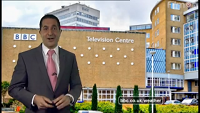 Moving out…As the BBC Television Centre site was now going to be substantially redeveloped to include apartments and office space amongst other uses including new television studios, the final BBC One news broadcast from the ‘old’ Television Centre took place on 18 March 2013, followed by programmes shown on 22 March comprising of a concert featuring the group Madness followed by a farewell programme: Goodbye Television Centre, both broadcast on BBC Four. Originally tried as a one-off Christmas special in 2015, 2016 saw the introduction of Michael McIntyre’s Big Show as a series with celebrity guests and features based around members of the public which recall earlier entertainment formats such as Noel’s House Party and The Late Late Breakfast Show.
Moving out…As the BBC Television Centre site was now going to be substantially redeveloped to include apartments and office space amongst other uses including new television studios, the final BBC One news broadcast from the ‘old’ Television Centre took place on 18 March 2013, followed by programmes shown on 22 March comprising of a concert featuring the group Madness followed by a farewell programme: Goodbye Television Centre, both broadcast on BBC Four. Originally tried as a one-off Christmas special in 2015, 2016 saw the introduction of Michael McIntyre’s Big Show as a series with celebrity guests and features based around members of the public which recall earlier entertainment formats such as Noel’s House Party and The Late Late Breakfast Show.
 BBC One’s on-screen identity based around circles had served the channel well for ten years but by the start of 2017 it was inevitably considered to be time for a new look for the channel. A new identity package was introduced that was built around the concept of ‘oneness’, namely the shared experiences of groups of people such as roller skaters (pictured), an exercise class, wheelchair athletes, tandem cyclists, night kayakers, etc., and inevitably this invited some comparisons with the dance-and-movement idents used from 2002-2006 except this time there was no dancing and no accompanying music.
BBC One’s on-screen identity based around circles had served the channel well for ten years but by the start of 2017 it was inevitably considered to be time for a new look for the channel. A new identity package was introduced that was built around the concept of ‘oneness’, namely the shared experiences of groups of people such as roller skaters (pictured), an exercise class, wheelchair athletes, tandem cyclists, night kayakers, etc., and inevitably this invited some comparisons with the dance-and-movement idents used from 2002-2006 except this time there was no dancing and no accompanying music.
 2017 also saw the delayed completion of Television Centre refurbishment under new owners, with BBC Studioworks (a separate private company) now in charge of Television Centre’s three studios and post-production facilities which officially re-opened on 1 September 2017, with programmes such as the new music show Sounds Like Friday Night already making use of them.
2017 also saw the delayed completion of Television Centre refurbishment under new owners, with BBC Studioworks (a separate private company) now in charge of Television Centre’s three studios and post-production facilities which officially re-opened on 1 September 2017, with programmes such as the new music show Sounds Like Friday Night already making use of them.
 Christmas 2017 saw the introduction of a new festive package of idents and on-screen graphics, and it soon became clear that there was a new star of the show (so to speak). A promotional animation featuring a girl and her father where the girl suffers stage fright at a school concert proved to be popular with many viewers, and also formed the basis for short ‘stings’ and idents shown during the Christmas period such as this pictured ident where father and daughter are trying to fix Christmas lights.
Christmas 2017 saw the introduction of a new festive package of idents and on-screen graphics, and it soon became clear that there was a new star of the show (so to speak). A promotional animation featuring a girl and her father where the girl suffers stage fright at a school concert proved to be popular with many viewers, and also formed the basis for short ‘stings’ and idents shown during the Christmas period such as this pictured ident where father and daughter are trying to fix Christmas lights.
 From early 2018 the BBC began a gradual corporate-wide roll out of a new font entitled ‘Reith’ to replace Gill Sans (Gill Sans also requiring an expensive corporate licence for its usage), though the new font wasn’t generally used for on-screen presentation until October 2021 when a new look was introduced across most of the television channels. Some areas such as News and online had to wait a little longer before updating, so initially the BBC logo refresh wasn’t as comprehensive as it was back in 1997.
From early 2018 the BBC began a gradual corporate-wide roll out of a new font entitled ‘Reith’ to replace Gill Sans (Gill Sans also requiring an expensive corporate licence for its usage), though the new font wasn’t generally used for on-screen presentation until October 2021 when a new look was introduced across most of the television channels. Some areas such as News and online had to wait a little longer before updating, so initially the BBC logo refresh wasn’t as comprehensive as it was back in 1997.
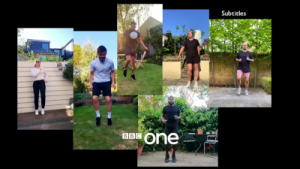 The beginning of 2020 saw a major global COVID pandemic breaking out which necessitated a fundamental rethink of ‘Oneness’ as a branding concept for BBC One, because if groups of people could no longer safely congregate together for fear of transmitting a potentially deadly virus, showing groups of people as ‘Oneness’ would obviously be no longer appropriate. Hence ‘lockdown Oneness’ was introduced, with a new selection of idents showing groups of people, pets or objects in separate rectangles but congregated together virtually, therefore showing solidarity with people confined to their homes for health reasons. Likewise various programmes were badly affected by social distancing measures introduced to avoid infection; the production of drama series such as EastEnders were put on hold and other programmes such as Have I Got News For You, The One Show and The Ranganation were rejigged to avoid using studio audiences as well as making use of ‘virtual guests’ using video links.
The beginning of 2020 saw a major global COVID pandemic breaking out which necessitated a fundamental rethink of ‘Oneness’ as a branding concept for BBC One, because if groups of people could no longer safely congregate together for fear of transmitting a potentially deadly virus, showing groups of people as ‘Oneness’ would obviously be no longer appropriate. Hence ‘lockdown Oneness’ was introduced, with a new selection of idents showing groups of people, pets or objects in separate rectangles but congregated together virtually, therefore showing solidarity with people confined to their homes for health reasons. Likewise various programmes were badly affected by social distancing measures introduced to avoid infection; the production of drama series such as EastEnders were put on hold and other programmes such as Have I Got News For You, The One Show and The Ranganation were rejigged to avoid using studio audiences as well as making use of ‘virtual guests’ using video links.
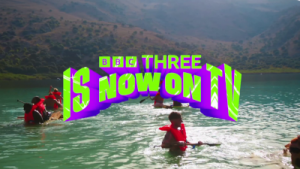 One surprise was the return of BBC Three as a TV channel in February 2022. Obviously it was thought that BBC Three was still a valuable proposition as a traditional linear TV channel and it still wasn’t as relevant when restricted as an iPlayer-only service. Clearly linear TV is still appreciated by lots of young people despite the rise of the BBC’s iPlayer and commercial streaming services such as Netflix, Disney+ and Amazon Prime Video.
One surprise was the return of BBC Three as a TV channel in February 2022. Obviously it was thought that BBC Three was still a valuable proposition as a traditional linear TV channel and it still wasn’t as relevant when restricted as an iPlayer-only service. Clearly linear TV is still appreciated by lots of young people despite the rise of the BBC’s iPlayer and commercial streaming services such as Netflix, Disney+ and Amazon Prime Video.
 The worldwide decline of the ‘soap opera’ (serial drama) combined with recent budget cuts caused by government freezing of the TV licence fee (still the BBC’s primary income at this point) meant that the BBC took a decision to cancel medical drama series Holby City. On air since 12 January 1999, Holby City was basically a complementary series to Casualty. The last episode was transmitted on 29 March 2022 and Holby City as a whole was fundamentally a ‘love letter’ to the NHS.
The worldwide decline of the ‘soap opera’ (serial drama) combined with recent budget cuts caused by government freezing of the TV licence fee (still the BBC’s primary income at this point) meant that the BBC took a decision to cancel medical drama series Holby City. On air since 12 January 1999, Holby City was basically a complementary series to Casualty. The last episode was transmitted on 29 March 2022 and Holby City as a whole was fundamentally a ‘love letter’ to the NHS.
 1 April 2022 finally saw the previously-delayed introduction of new ‘lens’ idents based around a rotating ‘sphere’ or lens effect incorporating two or more live action scenes. Several idents feature different scenes including a dance floor, park bench, skateboard park and outdoors late at night.
1 April 2022 finally saw the previously-delayed introduction of new ‘lens’ idents based around a rotating ‘sphere’ or lens effect incorporating two or more live action scenes. Several idents feature different scenes including a dance floor, park bench, skateboard park and outdoors late at night.
 2022 represents a major milestone for the BBC as a whole, being the 100th anniversary of both the BBC being incorporated as a company (18 October) and the first 2LO broadcast on November 14…
2022 represents a major milestone for the BBC as a whole, being the 100th anniversary of both the BBC being incorporated as a company (18 October) and the first 2LO broadcast on November 14…
 Before the 1980s, schools programmes were almost always watched live as transmitted since there was usually no means of recording them for later use (video recorders only became available to schools from the mid-1960s onwards, were very expensive to purchase and the tapes were pricey as well), so there had to be a delay of at least two minutes before and after each broadcast gave extra time for teachers to file a class of pupils in (and out) of a room that contained a television. In May 1952, the BBC had experimented with schools television via a direct cable link to six schools from Alexandra Palace, but it would be another five years before schools programmes were actually broadcast by the BBC. Under the guidance of Paul Adorian, Associated-Rediffusion commenced the broadcast of schools programmes on 13 May 1957.
Before the 1980s, schools programmes were almost always watched live as transmitted since there was usually no means of recording them for later use (video recorders only became available to schools from the mid-1960s onwards, were very expensive to purchase and the tapes were pricey as well), so there had to be a delay of at least two minutes before and after each broadcast gave extra time for teachers to file a class of pupils in (and out) of a room that contained a television. In May 1952, the BBC had experimented with schools television via a direct cable link to six schools from Alexandra Palace, but it would be another five years before schools programmes were actually broadcast by the BBC. Under the guidance of Paul Adorian, Associated-Rediffusion commenced the broadcast of schools programmes on 13 May 1957.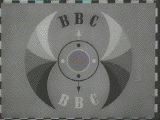 Television sets manufactured before the 1970s made extensive use of valves as opposed to more reliable “solid state” components such as transistors and integrated circuits; these valve-based sets often required adjustment of controls such as brightness and vertical hold before the start of the programme as well as allowing for a period for the TV to have warmed up properly, hence the BBC showing a caption known as a tuning signal for a while before the programme starts which enabled the teacher to make last minute adjustments to the picture settings if required. This Abram Games-designed “angel wings” tuning signal was shown before the start of each days’ broadcast in the 1950s, and continued to be used before schools programmes up until circa 1964, even after its use had been discontinued elsewhere.
Television sets manufactured before the 1970s made extensive use of valves as opposed to more reliable “solid state” components such as transistors and integrated circuits; these valve-based sets often required adjustment of controls such as brightness and vertical hold before the start of the programme as well as allowing for a period for the TV to have warmed up properly, hence the BBC showing a caption known as a tuning signal for a while before the programme starts which enabled the teacher to make last minute adjustments to the picture settings if required. This Abram Games-designed “angel wings” tuning signal was shown before the start of each days’ broadcast in the 1950s, and continued to be used before schools programmes up until circa 1964, even after its use had been discontinued elsewhere.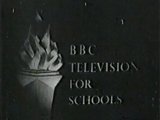 The first transmitted BBC programme for schools (Geography) was broadcast on 24 September 1957 from the Lime Grove studios, with only one schools programme shown each afternoon during term time to begin with, and all the initial programmes such as Living In The Commonwealth and Science and Life were predominantly aimed at older children. A short 5 second filmed ident sequence with orchestral accompaniment was used to introduce BBC Television For Schools (as it was called), and we can perhaps assume that this film was used as an opening sequence for schools programmes until the summer term of 1960; it had certainly been dropped by 1962 when the “Schools Opening Film” was 1 minute long in duration.
The first transmitted BBC programme for schools (Geography) was broadcast on 24 September 1957 from the Lime Grove studios, with only one schools programme shown each afternoon during term time to begin with, and all the initial programmes such as Living In The Commonwealth and Science and Life were predominantly aimed at older children. A short 5 second filmed ident sequence with orchestral accompaniment was used to introduce BBC Television For Schools (as it was called), and we can perhaps assume that this film was used as an opening sequence for schools programmes until the summer term of 1960; it had certainly been dropped by 1962 when the “Schools Opening Film” was 1 minute long in duration. During the last second of the ident sequence, the torch (and the caption) momentarily flickered brighter before the continuity announcer appeared on-screen to formally introduce the programme; something that may also relate to the flashes of light used for the “bat’s wings” logo from the same period. (Indeed, elements of the “bat’s wings” design with flashes of light could be seen being used in schools continuity until October 1961; a year after it was discontinued elsewhere.) Even by 1950s standards, this style of on-screen presentation was surprisingly old-fashioned but presumably a traditional look was adopted in order to appeal to teachers that were reluctant to embrace modern technology in the classroom. However despite an initial lack of programming, schools quickly warmed to the idea of television as a teaching medium and they were eagerly buying televisions to such an extent that they had to be restrained from excessively doing so.
During the last second of the ident sequence, the torch (and the caption) momentarily flickered brighter before the continuity announcer appeared on-screen to formally introduce the programme; something that may also relate to the flashes of light used for the “bat’s wings” logo from the same period. (Indeed, elements of the “bat’s wings” design with flashes of light could be seen being used in schools continuity until October 1961; a year after it was discontinued elsewhere.) Even by 1950s standards, this style of on-screen presentation was surprisingly old-fashioned but presumably a traditional look was adopted in order to appeal to teachers that were reluctant to embrace modern technology in the classroom. However despite an initial lack of programming, schools quickly warmed to the idea of television as a teaching medium and they were eagerly buying televisions to such an extent that they had to be restrained from excessively doing so.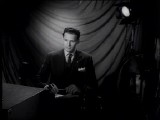 A promotional film This is the BBC gives us a brief insight into the production of schools programmes during the late 1950s; the continuity announcer pictured here is introducing Programme 3 of the series Transport and Communication. The BBC actually referred to schools broadcasts in period literature as being “Broadcasts To Schools”.
A promotional film This is the BBC gives us a brief insight into the production of schools programmes during the late 1950s; the continuity announcer pictured here is introducing Programme 3 of the series Transport and Communication. The BBC actually referred to schools broadcasts in period literature as being “Broadcasts To Schools”.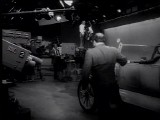 Programme 3 of the aforementioned Transport and Communication series was all about the history of the motor car, so an example of the very first mass produced car – the Model T Ford – was placed in the studio. The presenter was Arthur Garratt (pictured here next to the car).
Programme 3 of the aforementioned Transport and Communication series was all about the history of the motor car, so an example of the very first mass produced car – the Model T Ford – was placed in the studio. The presenter was Arthur Garratt (pictured here next to the car).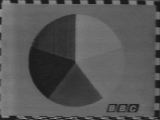 The tuning signal caption shown here is likely to have been first used as early as Autumn Term 1960 (when a morning schools programme was introduced); it was used before the start of each schools programme and consisted of a circle divided into five segments of black, white and three shades of grey in the style of a pie chart on a pale grey background, hence the term “BBC Schools Pie Chart”. From (at least) 1964 to 1967 there was a countdown sequence used before the start of the programme which had the pie chart slowly disappear; the circular chart was divided into small segments, with each segment of the pie chart being replaced by the corresponding segment of a plain clock face (identical to the clock face below minus the second hand) starting from the top, one for each second in a clockwise direction. A piece of music written by Lionel Salter entitled “We are almost ready to begin” was used to accompany the animation from 1964 onwards, and the tune’s duration was 1 minute 55 seconds, with 5 seconds’ silence for the announcement ID. (The first pie chart was also branded ‘BBC tv’ unlike the BBC branding shown here that was used from 1967 onwards.)
The tuning signal caption shown here is likely to have been first used as early as Autumn Term 1960 (when a morning schools programme was introduced); it was used before the start of each schools programme and consisted of a circle divided into five segments of black, white and three shades of grey in the style of a pie chart on a pale grey background, hence the term “BBC Schools Pie Chart”. From (at least) 1964 to 1967 there was a countdown sequence used before the start of the programme which had the pie chart slowly disappear; the circular chart was divided into small segments, with each segment of the pie chart being replaced by the corresponding segment of a plain clock face (identical to the clock face below minus the second hand) starting from the top, one for each second in a clockwise direction. A piece of music written by Lionel Salter entitled “We are almost ready to begin” was used to accompany the animation from 1964 onwards, and the tune’s duration was 1 minute 55 seconds, with 5 seconds’ silence for the announcement ID. (The first pie chart was also branded ‘BBC tv’ unlike the BBC branding shown here that was used from 1967 onwards.)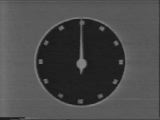 From 1967 until (at least) November 1974, the ‘vanishing segments’ animation used for the final minute was replaced by this simple clock face with a single continuously moving second hand, though the pie chart itself was still being shown prior to the final minute countdown to the programme start; the accompanying music now being used was usually a percussive piece known as “Guadalajara” that was written by Leonard Salzedo (who also wrote the Open University theme that was the first few bars of a longer piece). Broadcast quality copies (albeit recorded on film) of this pie chart and clock sequence exist before the start of some BBC Northern Ireland schools programmes because an ident was sometimes recorded alongside the programme.
From 1967 until (at least) November 1974, the ‘vanishing segments’ animation used for the final minute was replaced by this simple clock face with a single continuously moving second hand, though the pie chart itself was still being shown prior to the final minute countdown to the programme start; the accompanying music now being used was usually a percussive piece known as “Guadalajara” that was written by Leonard Salzedo (who also wrote the Open University theme that was the first few bars of a longer piece). Broadcast quality copies (albeit recorded on film) of this pie chart and clock sequence exist before the start of some BBC Northern Ireland schools programmes because an ident was sometimes recorded alongside the programme.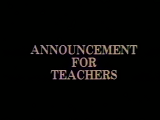 Occasionally an “Announcement For Teachers” may have been read during the final minute whilst the clock hand was steadily moving around the face to the 12 o’clock position when the programme starts, with this caption being overlaid on the clock, but more commonly such announcements were made at other times when this caption on its own would have been displayed. (The same caption was also used later in the 1970s for announcements.)
Occasionally an “Announcement For Teachers” may have been read during the final minute whilst the clock hand was steadily moving around the face to the 12 o’clock position when the programme starts, with this caption being overlaid on the clock, but more commonly such announcements were made at other times when this caption on its own would have been displayed. (The same caption was also used later in the 1970s for announcements.)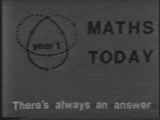 Then of course there were the programmes themselves – BBC Schools programming caters for a wide range of subjects and abilities, with series such as Maths Today and Maths Workshop (for older children); the latter being shown well into the 1970s despite being made in black and white. Programmes were often repeated for the benefit of teachers so that they could try and incorporate them into the school timetable which was often difficult since many schools had no form of video recording at that time.
Then of course there were the programmes themselves – BBC Schools programming caters for a wide range of subjects and abilities, with series such as Maths Today and Maths Workshop (for older children); the latter being shown well into the 1970s despite being made in black and white. Programmes were often repeated for the benefit of teachers so that they could try and incorporate them into the school timetable which was often difficult since many schools had no form of video recording at that time.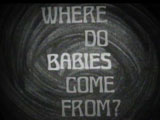 Here is an example of a BBC Schools sex education programme from the late 1960s that would inevitably provide a useful classroom resource triggering a discussion about the facts of life, with television being able to provide a far more powerful illustrative medium compared to books or blackboard drawings for this particular topic.
Here is an example of a BBC Schools sex education programme from the late 1960s that would inevitably provide a useful classroom resource triggering a discussion about the facts of life, with television being able to provide a far more powerful illustrative medium compared to books or blackboard drawings for this particular topic. Very occasionally the pie chart tuning signal itself would feature as part of an engineering test startup sequence if such a test was scheduled for a weekday morning during term time, in which case the pie chart tuning signal would appear on screen then very slowly fade away over the course of a minute to leave a black screen before appearing again shortly before the start of the first programme. The sequence would also feature a greyscale (sawtooth) tuning pattern with tone.
Very occasionally the pie chart tuning signal itself would feature as part of an engineering test startup sequence if such a test was scheduled for a weekday morning during term time, in which case the pie chart tuning signal would appear on screen then very slowly fade away over the course of a minute to leave a black screen before appearing again shortly before the start of the first programme. The sequence would also feature a greyscale (sawtooth) tuning pattern with tone.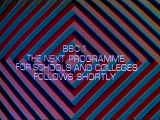 With more and more schools programmes being made in colour as well as more and more schools acquiring colour TV’s – though there were still a significant number of primary schools in particular that had only black and white televisions even at the end of the 1970s – the pie chart’s days were obviously numbered, therefore something more contemporary was devised for schools programme presentation.
With more and more schools programmes being made in colour as well as more and more schools acquiring colour TV’s – though there were still a significant number of primary schools in particular that had only black and white televisions even at the end of the 1970s – the pie chart’s days were obviously numbered, therefore something more contemporary was devised for schools programme presentation.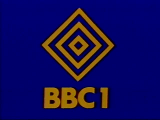
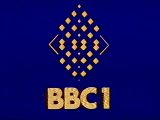
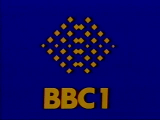
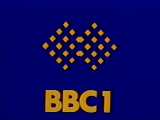
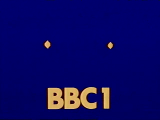
 Examples of BBC Schools programmes shown during the 1970s include A Good Read, A Job Worth Doing?, Going To Work, Maths Topics, Mathshow, Merry-go-round for primary school children, Scene, Swim, and Watch. Some of these programmes continued to be produced or shown for years after the 1970s but the introduction of GCSE qualifications (replacing ‘O’ levels, with the first GCSE exams in the Summer of 1988) made some of these old programmes redundant.
Examples of BBC Schools programmes shown during the 1970s include A Good Read, A Job Worth Doing?, Going To Work, Maths Topics, Mathshow, Merry-go-round for primary school children, Scene, Swim, and Watch. Some of these programmes continued to be produced or shown for years after the 1970s but the introduction of GCSE qualifications (replacing ‘O’ levels, with the first GCSE exams in the Summer of 1988) made some of these old programmes redundant.

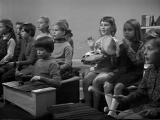
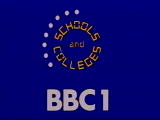 From 1977 onwards until the Summer Term of 1983 a “dots clock” was used as a replacement for the diamond animation before schools programmes, with a full circle of dots shown when the clock first appears. When watching the dots disappear one by one clockwise each second as the clock counts down to the start of the programme, you may notice that the dots don’t instantly disappear but seem to shrink as they vanish due to the mechanical nature of the clock. Various pieces of music were used to accompany the clock, including Cat Stevens’ Remember the days of the old schoolyard, a medley of ABBA songs and a rather memorable cover version of the original Star Wars theme. Originally the Schools and Colleges logo in the centre of the clock rotated every so often but it’s very likely that the turning mechanism broke down early on because the logo became static at some point not too long after the clock was first used.
From 1977 onwards until the Summer Term of 1983 a “dots clock” was used as a replacement for the diamond animation before schools programmes, with a full circle of dots shown when the clock first appears. When watching the dots disappear one by one clockwise each second as the clock counts down to the start of the programme, you may notice that the dots don’t instantly disappear but seem to shrink as they vanish due to the mechanical nature of the clock. Various pieces of music were used to accompany the clock, including Cat Stevens’ Remember the days of the old schoolyard, a medley of ABBA songs and a rather memorable cover version of the original Star Wars theme. Originally the Schools and Colleges logo in the centre of the clock rotated every so often but it’s very likely that the turning mechanism broke down early on because the logo became static at some point not too long after the clock was first used.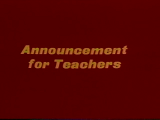 Autumn Term 1983 saw schools programmes permanently move to BBC2 and the use of a dots clock was abandoned at this point in favour of a more conventional “Daytime on 2” style of continuity, though the “Coming Shortly…” method of filling short gaps in the schedule continued for a while longer as well as a 15 second digital countdown timer being adopted later on in the decade. More and more schools now had video recorders so could easily record programmes and play them back at times to suit the lessons as opposed to timing the lessons to fit in with the television programmes.
Autumn Term 1983 saw schools programmes permanently move to BBC2 and the use of a dots clock was abandoned at this point in favour of a more conventional “Daytime on 2” style of continuity, though the “Coming Shortly…” method of filling short gaps in the schedule continued for a while longer as well as a 15 second digital countdown timer being adopted later on in the decade. More and more schools now had video recorders so could easily record programmes and play them back at times to suit the lessons as opposed to timing the lessons to fit in with the television programmes.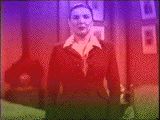 Prior to the 1960s, this is how a few people had their first view of ‘colour’ television – in the 1950s you could buy a ‘colourising’ filter, place it over your existing black and white screen, and let your imagination do the rest… John Logie Baird, the pioneer of television, was working on stereoscopic colour television shortly before his death in 1946, and the Americans were conducting experiments. But the technology was very complex; the problem was how to transmit colour information alongside an existing black and white image, therefore maintaining ‘backwards’ compatibility with existing receivers.
Prior to the 1960s, this is how a few people had their first view of ‘colour’ television – in the 1950s you could buy a ‘colourising’ filter, place it over your existing black and white screen, and let your imagination do the rest… John Logie Baird, the pioneer of television, was working on stereoscopic colour television shortly before his death in 1946, and the Americans were conducting experiments. But the technology was very complex; the problem was how to transmit colour information alongside an existing black and white image, therefore maintaining ‘backwards’ compatibility with existing receivers.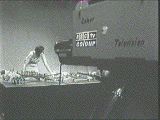 From 10 October 1955 the BBC experimented with colour television, firstly with a 405 line version of the American NTSC system – the first generally available electronic-based system of colour transmission designed for backwards compatability with existing monochrome transmissions. Low power test transmissions were from Alexandra Palace (one of the original studios being re-equipped for the purpose), using specially made receivers, but to start a public 405-line colour service at this stage would result in Britain having to commit long term to the pre-war 405-line standard which was out of step with continental Europe (which used the superior post-war 625 line system).
From 10 October 1955 the BBC experimented with colour television, firstly with a 405 line version of the American NTSC system – the first generally available electronic-based system of colour transmission designed for backwards compatability with existing monochrome transmissions. Low power test transmissions were from Alexandra Palace (one of the original studios being re-equipped for the purpose), using specially made receivers, but to start a public 405-line colour service at this stage would result in Britain having to commit long term to the pre-war 405-line standard which was out of step with continental Europe (which used the superior post-war 625 line system).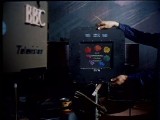
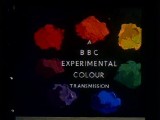
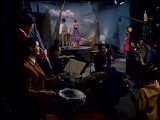 The song used in this particular test broadcast was “Early one morning”, and the participants had to wear different makeup compared with that used for monochrome broadcasts as well as brightly-coloured costumes featuring different colours.
The song used in this particular test broadcast was “Early one morning”, and the participants had to wear different makeup compared with that used for monochrome broadcasts as well as brightly-coloured costumes featuring different colours.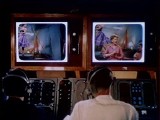 A major problem with early colour television equipment was its unreliability combined with the huge number of adjustments that were required for a good quality picture. The colour television receivers used for the BBC tests were individually handbuilt by companies such as Bush and Philips, with various specialist components such as colour television tubes having to be sourced from America; the sets themselves were designed to be easily maintainable by engineers despite their huge complexity, which was particularly true of the receivers constructed for the later PAL tests.
A major problem with early colour television equipment was its unreliability combined with the huge number of adjustments that were required for a good quality picture. The colour television receivers used for the BBC tests were individually handbuilt by companies such as Bush and Philips, with various specialist components such as colour television tubes having to be sourced from America; the sets themselves were designed to be easily maintainable by engineers despite their huge complexity, which was particularly true of the receivers constructed for the later PAL tests.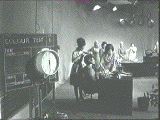 Later the French developed SECAM (Sequential Colour with Memory), and Telefunken in Germany developed PAL (Phase Alternate Line) which represented two differing approaches of solving the colour problems encountered with NTSC, and the BBC experimented using both, though there were other problems to be solved. The insensitivity and inaccuracy of early colour tv cameras and its associated circuitry meant that without adjustments the resulting picture either had a colour cast and/or made flesh tones look too red, so extra studio lighting and make-up was required. In 1961 a committee meeting in Stockholm allocated UHF frequencies for 36 European countries, enabling the Government to plan ahead.
Later the French developed SECAM (Sequential Colour with Memory), and Telefunken in Germany developed PAL (Phase Alternate Line) which represented two differing approaches of solving the colour problems encountered with NTSC, and the BBC experimented using both, though there were other problems to be solved. The insensitivity and inaccuracy of early colour tv cameras and its associated circuitry meant that without adjustments the resulting picture either had a colour cast and/or made flesh tones look too red, so extra studio lighting and make-up was required. In 1961 a committee meeting in Stockholm allocated UHF frequencies for 36 European countries, enabling the Government to plan ahead.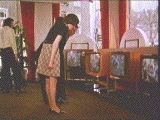 After much deliberation, the government chose the PAL system – which although was more complex (hence expensive) it gave the best results. Most of Europe also chose PAL, and BBC2 started its UHF 625-line colour service on 1 July 1967 with Wimbledon tennis coverage (there were a few earlier test transmissions), though initially only a few programmes in the schedule were actually in colour. BBC2’s first colour ident was simply the standard ‘2’ logo electronically-tinted pale blue.
After much deliberation, the government chose the PAL system – which although was more complex (hence expensive) it gave the best results. Most of Europe also chose PAL, and BBC2 started its UHF 625-line colour service on 1 July 1967 with Wimbledon tennis coverage (there were a few earlier test transmissions), though initially only a few programmes in the schedule were actually in colour. BBC2’s first colour ident was simply the standard ‘2’ logo electronically-tinted pale blue.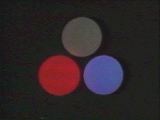
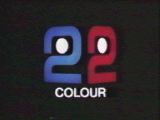
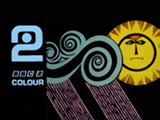 By December 1967 colour was available in London, the Midlands, the North and South of England. Other early colour programmes included The World About Us (which basically used stock colour documentary footage – the first programme featured volcanoes), Almost Human (about domesticated animals) and International Cabaret. The BBC-produced 1968 Eurovision Song Contest was shown live in black-and-white on BBC1 and in colour in West Germany but repeated the next day in colour on BBC2.
By December 1967 colour was available in London, the Midlands, the North and South of England. Other early colour programmes included The World About Us (which basically used stock colour documentary footage – the first programme featured volcanoes), Almost Human (about domesticated animals) and International Cabaret. The BBC-produced 1968 Eurovision Song Contest was shown live in black-and-white on BBC1 and in colour in West Germany but repeated the next day in colour on BBC2.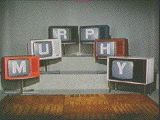 There were many more manufacturers of television receivers in the 1960s than there are today; Sobell, MacMichael, GEC, Ekco, HMV, ITT, and Ferguson were just a few of the more notable ones, though later on more obscure models were imported to meet increasing demand. Early colour television sets used valves and were very bulky, expensive, unreliable, some had poor colour quality, and some sets were prone to overheating. After a succession of house fires people were advised to stay in the same room as their television for one hour after it was switched off.
There were many more manufacturers of television receivers in the 1960s than there are today; Sobell, MacMichael, GEC, Ekco, HMV, ITT, and Ferguson were just a few of the more notable ones, though later on more obscure models were imported to meet increasing demand. Early colour television sets used valves and were very bulky, expensive, unreliable, some had poor colour quality, and some sets were prone to overheating. After a succession of house fires people were advised to stay in the same room as their television for one hour after it was switched off.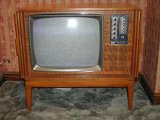 The HMV Colourmaster was a colour television featuring a genuine world-first: an all-transistor chassis with no valves apart from the cathode ray tube which technically speaking is a valve in itself; a design practice that was soon to be universally adopted. Despite a lack of valves, the Colourmaster was still a very bulky television due to the complexity of the transistor circuitry and the sheer bulk of the colour display tube. Available in 19″ and 25″ sizes, the price of the 25″ Colourmaster was an eye-watering £362.18s (pre-decimal) in 1968, so it’s no wonder that colour televisions were usually rented as opposed to purchased outright. (By comparison you could buy a very decent black and white television for a quarter of the price.)
The HMV Colourmaster was a colour television featuring a genuine world-first: an all-transistor chassis with no valves apart from the cathode ray tube which technically speaking is a valve in itself; a design practice that was soon to be universally adopted. Despite a lack of valves, the Colourmaster was still a very bulky television due to the complexity of the transistor circuitry and the sheer bulk of the colour display tube. Available in 19″ and 25″ sizes, the price of the 25″ Colourmaster was an eye-watering £362.18s (pre-decimal) in 1968, so it’s no wonder that colour televisions were usually rented as opposed to purchased outright. (By comparison you could buy a very decent black and white television for a quarter of the price.)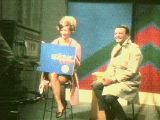 By 1968 many ITV franchises realised that they too had to prepare themselves for a future colour service. The first to do so was TWW, followed closely by ABC: ironically both were to lose their franchise the same year (though ABC joined up with Rediffusion to form Thames). TWW’s first (and hence ITV’s first) colour camera production (pictured) was Colour One – it was directed by Mike Towers (later Managing Director of HTV) and was done purely for internal demonstration purposes. No recording exists because there was nothing available to record it with.
By 1968 many ITV franchises realised that they too had to prepare themselves for a future colour service. The first to do so was TWW, followed closely by ABC: ironically both were to lose their franchise the same year (though ABC joined up with Rediffusion to form Thames). TWW’s first (and hence ITV’s first) colour camera production (pictured) was Colour One – it was directed by Mike Towers (later Managing Director of HTV) and was done purely for internal demonstration purposes. No recording exists because there was nothing available to record it with.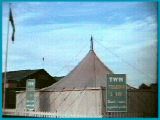 TWW also took out their colour cameras (EMI type 204 Vidicon using mirror optical splitting and a turret of wide angle adaptors, originally made for medical applications) for publicity demonstrations – pictured is the TWW tent at a Welsh Eisteddfod. The colour equipment used was a work of ingenuity – only a single RGB monitor was available and the only colour encoder available was a NTSC encoder, so it had to be modified to provide a PAL output which was no easy task.
TWW also took out their colour cameras (EMI type 204 Vidicon using mirror optical splitting and a turret of wide angle adaptors, originally made for medical applications) for publicity demonstrations – pictured is the TWW tent at a Welsh Eisteddfod. The colour equipment used was a work of ingenuity – only a single RGB monitor was available and the only colour encoder available was a NTSC encoder, so it had to be modified to provide a PAL output which was no easy task.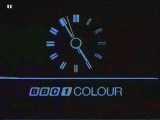
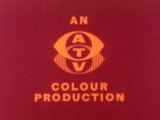
 During the early 1970s much of England, Wales, Northern Ireland, and Scotland were still totally without colour television, and despite a mini-budget in July 1971 boosting sales, by 1972 only 17% of households had colour television receivers though the Olympic Games in that year did help to stimulate interest. However tales of overheating and unreliability still put off many potential purchasers and the cost was still prohibitive for some, though TV rental provided an affordable alternative to outright purchase.
During the early 1970s much of England, Wales, Northern Ireland, and Scotland were still totally without colour television, and despite a mini-budget in July 1971 boosting sales, by 1972 only 17% of households had colour television receivers though the Olympic Games in that year did help to stimulate interest. However tales of overheating and unreliability still put off many potential purchasers and the cost was still prohibitive for some, though TV rental provided an affordable alternative to outright purchase.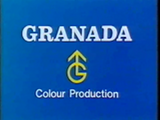 By 1976 colour television sets were smaller, far more reliable and they no longer caught fire due to their ‘solid-state’ design, meaning that no valves are used apart from the picture tube. Portable colour televisions became available, though most of these were still tied to the mains supply due to their high power consumption; the exceptions usually had 10 inch or smaller screens. Picture quality became vastly improved, and the falling price of sets meant that the number of colour televisions had rapidly increased to over 7.5 million by 1976. The Home Entertainment Show 1976 in London showcased recent innovations such as teletext, and colour transmissions finally reached the Channel Islands in the same year (it took a long time due to the technical difficulties in providing a UHF link to England).
By 1976 colour television sets were smaller, far more reliable and they no longer caught fire due to their ‘solid-state’ design, meaning that no valves are used apart from the picture tube. Portable colour televisions became available, though most of these were still tied to the mains supply due to their high power consumption; the exceptions usually had 10 inch or smaller screens. Picture quality became vastly improved, and the falling price of sets meant that the number of colour televisions had rapidly increased to over 7.5 million by 1976. The Home Entertainment Show 1976 in London showcased recent innovations such as teletext, and colour transmissions finally reached the Channel Islands in the same year (it took a long time due to the technical difficulties in providing a UHF link to England). By the end of the 1970s manufacturers were looking to add more features to their televisions, and the advent of reasonably priced silicon chip circuitry meant that special features such as teletext could be added (a free information service whereby information is transmitted as ‘pages’) as well as sometimes other short-lived features such as ‘viewdata’ (a primitive internet-style service using crude block graphics as well as text) and bat-and-ball style video games. Teletext was the only special feature that became popular because it was cheap to add and free to use, together with remote control operation and electronic tuning. Early wireless remote controls mainly used ultrasound waves which were inaudible to humans but could make dogs bark.
By the end of the 1970s manufacturers were looking to add more features to their televisions, and the advent of reasonably priced silicon chip circuitry meant that special features such as teletext could be added (a free information service whereby information is transmitted as ‘pages’) as well as sometimes other short-lived features such as ‘viewdata’ (a primitive internet-style service using crude block graphics as well as text) and bat-and-ball style video games. Teletext was the only special feature that became popular because it was cheap to add and free to use, together with remote control operation and electronic tuning. Early wireless remote controls mainly used ultrasound waves which were inaudible to humans but could make dogs bark.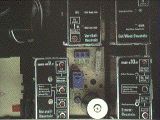 The 1980s and 1990s saw further developments in television design and technology. As early as the mid 1970s the German set maker Grundig had introduced a system using easily changeable internal modules with diagnostic lights so the set could even tell the engineer which part needed replacing. This idea never caught on but the basic concept of making the set simpler and cheaper to make remained. In 1983 Ferguson introduced the TX100 chassis, with some impressive claims (23% fewer adjustments, 5% fewer components, etc.), and new technologies continued to add features and reduce costs. NICAM stereo sound was introduced at the end of the 1980s, and television has continued to evolve since then with digital widescreen broadcasting commencing in 1998, high definition (HD) broadcasts beginning in the UK in 2006, and ultra high definition (UHD, or 4K) broadcasting is now a reality; experiments using this technology having taken place from 2012 onwards. Even higher resolutions are currently being considered though another brief flirtation with 3D television seems to have ended, at least for the time being.
The 1980s and 1990s saw further developments in television design and technology. As early as the mid 1970s the German set maker Grundig had introduced a system using easily changeable internal modules with diagnostic lights so the set could even tell the engineer which part needed replacing. This idea never caught on but the basic concept of making the set simpler and cheaper to make remained. In 1983 Ferguson introduced the TX100 chassis, with some impressive claims (23% fewer adjustments, 5% fewer components, etc.), and new technologies continued to add features and reduce costs. NICAM stereo sound was introduced at the end of the 1980s, and television has continued to evolve since then with digital widescreen broadcasting commencing in 1998, high definition (HD) broadcasts beginning in the UK in 2006, and ultra high definition (UHD, or 4K) broadcasting is now a reality; experiments using this technology having taken place from 2012 onwards. Even higher resolutions are currently being considered though another brief flirtation with 3D television seems to have ended, at least for the time being.
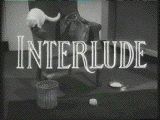 Programmes that featured flowers and plants were produced almost from day one; the very first week of programmes back in 1936 included one featuring prize chrysanthemums. Alexandra Palace (the BBC’s base from 1936 to 1960) has gardens which were an obvious choice to be used if the limited studio facilities were otherwise unavailable, though live outdoor programming was restricted sometimes by the unpredictable English weather.
Programmes that featured flowers and plants were produced almost from day one; the very first week of programmes back in 1936 included one featuring prize chrysanthemums. Alexandra Palace (the BBC’s base from 1936 to 1960) has gardens which were an obvious choice to be used if the limited studio facilities were otherwise unavailable, though live outdoor programming was restricted sometimes by the unpredictable English weather.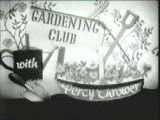 In 1956 the BBC started a monthly series that catered for real gardening enthusiasts, called Gardening Club. It was a big success, to such an extent that it established presenter Percy Thrower as a major celebrity (in a similar vein to Barry Bucknell, who was to be similiarly associated with do-it-yourself programmes).
In 1956 the BBC started a monthly series that catered for real gardening enthusiasts, called Gardening Club. It was a big success, to such an extent that it established presenter Percy Thrower as a major celebrity (in a similar vein to Barry Bucknell, who was to be similiarly associated with do-it-yourself programmes).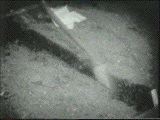 Outdoor television presents a whole set of challenges (rain, wind, etc.), but mishaps can still happen in the ‘controlled’ indoor studio environment. In order to effectively hear Percy Thrower’s voice, microphones were concealed in the soil (tiny radio microphones were yet to be developed), but once after he had finished putting plants into the soil, he started to water them, and since the concealed microphones were not waterproof…
Outdoor television presents a whole set of challenges (rain, wind, etc.), but mishaps can still happen in the ‘controlled’ indoor studio environment. In order to effectively hear Percy Thrower’s voice, microphones were concealed in the soil (tiny radio microphones were yet to be developed), but once after he had finished putting plants into the soil, he started to water them, and since the concealed microphones were not waterproof… In 1968 BBC2 were still experimenting with outdoor colour programming; the wide range of colours found in gardens were a natural choice for assessing colour accuracy. Six experimental gardening programmes were made using colour equipment; unfortunately all recordings of these have been lost.
In 1968 BBC2 were still experimenting with outdoor colour programming; the wide range of colours found in gardens were a natural choice for assessing colour accuracy. Six experimental gardening programmes were made using colour equipment; unfortunately all recordings of these have been lost.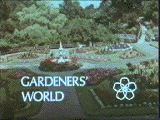 BBC2 (and colour television) was the natural home for gardening programmes, so Gardeners’ World started on Friday 5 January 1968 as a series to fulfill the demand for such programming. The main presenter was (again) Percy Thrower, though this time there were various co-presenters such as Arthur Billett, Kenneth Burras, Alice Coats and Geoffrey Smith. Gardeners’ World – with or without the apostrophe – has continued to the present day, albeit with an occasionally-changing roster of presenters.
BBC2 (and colour television) was the natural home for gardening programmes, so Gardeners’ World started on Friday 5 January 1968 as a series to fulfill the demand for such programming. The main presenter was (again) Percy Thrower, though this time there were various co-presenters such as Arthur Billett, Kenneth Burras, Alice Coats and Geoffrey Smith. Gardeners’ World – with or without the apostrophe – has continued to the present day, albeit with an occasionally-changing roster of presenters.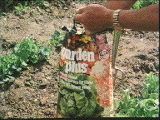 All was running smoothly until 1976, when Percy Thrower did (in many people’s eyes) the unthinkable and appeared in a TV commercial for Garden Plus fertiliser. His name was already associated with gardening products, but this commercial meant that it was possible for viewers to watch ITV and see him actively endorsing a product, then switch over to BBC2 and see him again in the garden. The result could have confused some people, as well as going against the principles of non-commercial television, so the BBC did what they thought was necessary by sacking him.
All was running smoothly until 1976, when Percy Thrower did (in many people’s eyes) the unthinkable and appeared in a TV commercial for Garden Plus fertiliser. His name was already associated with gardening products, but this commercial meant that it was possible for viewers to watch ITV and see him actively endorsing a product, then switch over to BBC2 and see him again in the garden. The result could have confused some people, as well as going against the principles of non-commercial television, so the BBC did what they thought was necessary by sacking him.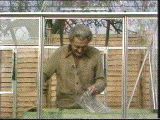 Life must go on (after all there’s the grass to be cut…), so Percy Thrower was replaced by Peter Seabrook, who didn’t exactly look like a typical gardener (quote: “He looked more like an accountant”), though the co-presenters such as Arthur Billit, Geoffrey Smith and Clay Jones (pictured) remained the same, helping to smooth the transition. Replacing Percy Thrower was always going to be difficult, but the loyalty of the viewers and the quality of the current and later presenters kept the show going. After all, the show was all about gardening and not personalities.
Life must go on (after all there’s the grass to be cut…), so Percy Thrower was replaced by Peter Seabrook, who didn’t exactly look like a typical gardener (quote: “He looked more like an accountant”), though the co-presenters such as Arthur Billit, Geoffrey Smith and Clay Jones (pictured) remained the same, helping to smooth the transition. Replacing Percy Thrower was always going to be difficult, but the loyalty of the viewers and the quality of the current and later presenters kept the show going. After all, the show was all about gardening and not personalities.
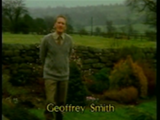
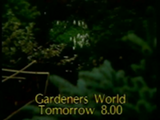 Geoffrey Smith featured in this promotion for a new series of Gardeners World (sometimes spelt without an apostrophe, as is the case here) in 1981, talking about tomato plants and how they are flowering earlier in the South of England compared to elsewhere in the UK.
Geoffrey Smith featured in this promotion for a new series of Gardeners World (sometimes spelt without an apostrophe, as is the case here) in 1981, talking about tomato plants and how they are flowering earlier in the South of England compared to elsewhere in the UK.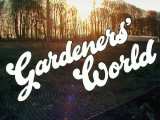 This is what the Gardeners’ World titles looked like in 1982 – at this point the theme music was still the same as it was in the 1970s – with the typeface employed bearing a resemblance to that used by a certain brand of flower seed.
This is what the Gardeners’ World titles looked like in 1982 – at this point the theme music was still the same as it was in the 1970s – with the typeface employed bearing a resemblance to that used by a certain brand of flower seed.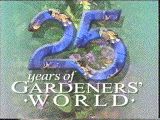 Garden technology may evolve with the introduction of more advanced pesticides, plant varieties and garden machinery, but Gardeners’ World still carried on regardless, celebrating its 25th anniversary in 1994. The show had been contracted out to independent producers in 1993 and some had complained about the changes, but the show must go on (as they say). In recent years the gardens featured have been in a wider range of locations due to smaller and lighter video equipment becoming available.
Garden technology may evolve with the introduction of more advanced pesticides, plant varieties and garden machinery, but Gardeners’ World still carried on regardless, celebrating its 25th anniversary in 1994. The show had been contracted out to independent producers in 1993 and some had complained about the changes, but the show must go on (as they say). In recent years the gardens featured have been in a wider range of locations due to smaller and lighter video equipment becoming available.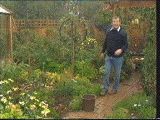 One of the best-loved presenters of Gardeners’ World was Geoff Hamilton (1990-1996), who tragically died from a heart attack shortly before the series Geoff Hamilton’s Paradise Gardens was completed (his brother helped to complete the final episode). His garden (known as Barnsdale) was an inspiration to tired gardeners everywhere; infact there had been two ‘Barnsdales’ (the first one had become too small); the larger final one actually comprising of no less than thirty separate smaller gardens.
One of the best-loved presenters of Gardeners’ World was Geoff Hamilton (1990-1996), who tragically died from a heart attack shortly before the series Geoff Hamilton’s Paradise Gardens was completed (his brother helped to complete the final episode). His garden (known as Barnsdale) was an inspiration to tired gardeners everywhere; infact there had been two ‘Barnsdales’ (the first one had become too small); the larger final one actually comprising of no less than thirty separate smaller gardens. As well as being a well-loved presenter, Geoff Hamilton made one very significant contribution to the world of agriculture (not just gardening), notably the promotion of organic methods of pest control and the elimination of chemicals from the food chain at a time when such methods had fallen out of favour (and organic food was virtually unobtainable). Also he wasn’t afraid to show viewers the results of such organic experiments even if they had failed, since the point of the exercise was to learn from these mistakes, and crucially these organic methods were presented as an alternative to the use of conventional pesticides (which were also used as a comparison) as opposed to only being told one way of doing things.
As well as being a well-loved presenter, Geoff Hamilton made one very significant contribution to the world of agriculture (not just gardening), notably the promotion of organic methods of pest control and the elimination of chemicals from the food chain at a time when such methods had fallen out of favour (and organic food was virtually unobtainable). Also he wasn’t afraid to show viewers the results of such organic experiments even if they had failed, since the point of the exercise was to learn from these mistakes, and crucially these organic methods were presented as an alternative to the use of conventional pesticides (which were also used as a comparison) as opposed to only being told one way of doing things. From 1996, Gardeners’ World continued with Alan Titchmarsh becoming the main presenter along with Pippa Greenwood and Gay Search being regular presenters in 1998 as the show reached its 30th year. Alan Titchmarsh subsequently moved on in 2002 to other areas such as replacing Sheridan Morley as the presenter of the Radio 2 Arts Programme, and Monty Don took over as the main presenter.
From 1996, Gardeners’ World continued with Alan Titchmarsh becoming the main presenter along with Pippa Greenwood and Gay Search being regular presenters in 1998 as the show reached its 30th year. Alan Titchmarsh subsequently moved on in 2002 to other areas such as replacing Sheridan Morley as the presenter of the Radio 2 Arts Programme, and Monty Don took over as the main presenter.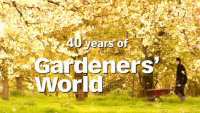 Gardeners’ World celebrated its 40th year in 2008 and still survives to this day despite competing series such as Ground Force vying for attention. Monty Don had to take a break in 2009 due to health concerns despite his popularity. He was replaced by co-presenter Toby Buckland in 2009, and after a short-lived revamp of the show that used 60 minute-long episodes with added features which had been likened (amongst other things) to elements of programmes such as popular motoring show Top Gear (by featuring a ‘cool wall’) and CBeebies by virtue of featuring young children, Gardeners’ World essentially returned to its roots in 2010 with a reversion to a 30-minute format, with Monty Don returning to the show soon afterwards.
Gardeners’ World celebrated its 40th year in 2008 and still survives to this day despite competing series such as Ground Force vying for attention. Monty Don had to take a break in 2009 due to health concerns despite his popularity. He was replaced by co-presenter Toby Buckland in 2009, and after a short-lived revamp of the show that used 60 minute-long episodes with added features which had been likened (amongst other things) to elements of programmes such as popular motoring show Top Gear (by featuring a ‘cool wall’) and CBeebies by virtue of featuring young children, Gardeners’ World essentially returned to its roots in 2010 with a reversion to a 30-minute format, with Monty Don returning to the show soon afterwards.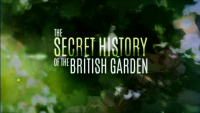 As well as Gardeners’ World there have been other gardening-related programmes including The Secret History of the British Garden, also presented by Monty Don. This four-part series covering the 17th, 18th, 19th and 20th centuries was originally broadcast in December 2017 and charted the progress of gardening from when it was a preserve of wealthy land owners and royalty right up to the present day as a mass market hobby. January 2018 is the 50th anniversary of Gardeners’ World and the UK’s love affair with horticulture shows no signs of going away.
As well as Gardeners’ World there have been other gardening-related programmes including The Secret History of the British Garden, also presented by Monty Don. This four-part series covering the 17th, 18th, 19th and 20th centuries was originally broadcast in December 2017 and charted the progress of gardening from when it was a preserve of wealthy land owners and royalty right up to the present day as a mass market hobby. January 2018 is the 50th anniversary of Gardeners’ World and the UK’s love affair with horticulture shows no signs of going away. The 1970s was a period of great change for television in general – at the start of the decade colour had only been available on BBC1 and ITV for a few months (and only from key main transmitters), and over half of programmes were still in black and white. The decade that brought bread shortages, power cuts, disco dancing, decimalisation, ABBA, and the Queen’s Silver Jubilee was also responsible for the following BBC children’s television programmes; just a small number of which are illustrated below for your enjoyment. (Just incase you were wondering about The White Seal, it was a cartoon based on a Rudyard Kipling story.)
The 1970s was a period of great change for television in general – at the start of the decade colour had only been available on BBC1 and ITV for a few months (and only from key main transmitters), and over half of programmes were still in black and white. The decade that brought bread shortages, power cuts, disco dancing, decimalisation, ABBA, and the Queen’s Silver Jubilee was also responsible for the following BBC children’s television programmes; just a small number of which are illustrated below for your enjoyment. (Just incase you were wondering about The White Seal, it was a cartoon based on a Rudyard Kipling story.)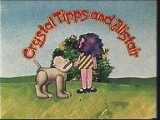

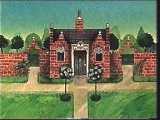
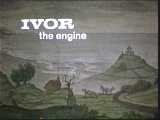
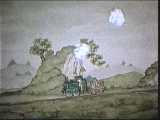
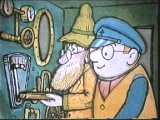
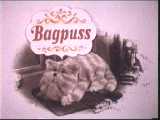
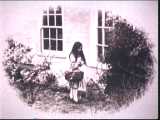
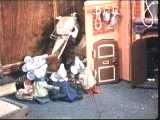
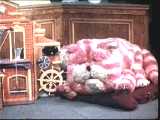 Bagpuss (1974) was a cleverly-conceived animation based around a saggy old cloth cat in a junk shop, which magically came to life together with the shop’s numerous other inhabitants such as Professor Yaffel the wooden woodpecker which normally served as a bookend. The girl Emily (second picture above) who owned Bagpuss was infact Peter Firmin’s youngest daughter. Many regard Bagpuss as the greatest childrens’ television programme of all time, though some may prefer the all-time classic Pogles Wood or The Clangers from the same Smallfilms stable.
Bagpuss (1974) was a cleverly-conceived animation based around a saggy old cloth cat in a junk shop, which magically came to life together with the shop’s numerous other inhabitants such as Professor Yaffel the wooden woodpecker which normally served as a bookend. The girl Emily (second picture above) who owned Bagpuss was infact Peter Firmin’s youngest daughter. Many regard Bagpuss as the greatest childrens’ television programme of all time, though some may prefer the all-time classic Pogles Wood or The Clangers from the same Smallfilms stable. Play School started life as the first proper programme to be transmitted on BBC2’s first day in 1964, after a power cut had wiped out what was to have been the official opening ceremony the night before. Play School soon went on to be a favourite with pre-school children to such an extent that a spinoff series Play Away was created for older children, and Play School itself continued throughout the 1970s right up to its eventual demise in 1988. Each edition was usually first shown on BBC2 in a mid-morning slot followed by a repeat showing on BBC1 for those viewers who couldn’t yet receive BBC2.
Play School started life as the first proper programme to be transmitted on BBC2’s first day in 1964, after a power cut had wiped out what was to have been the official opening ceremony the night before. Play School soon went on to be a favourite with pre-school children to such an extent that a spinoff series Play Away was created for older children, and Play School itself continued throughout the 1970s right up to its eventual demise in 1988. Each edition was usually first shown on BBC2 in a mid-morning slot followed by a repeat showing on BBC1 for those viewers who couldn’t yet receive BBC2.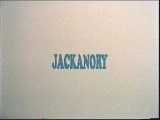


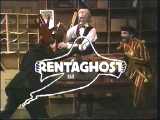
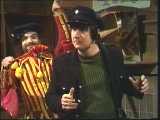
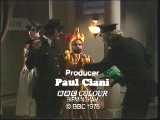

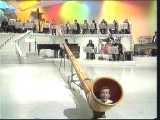
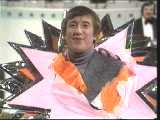


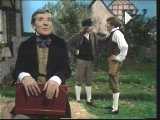
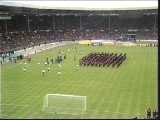 This feature is not about football or soccer itself (there are lots of other sites catering for football fans), but these pictures of the match between England and Scotland that took place at Wembley Stadium on 26 May 1979 help illustrate the BBC’s style of television presentation of football matches during the late 1970s/early 1980s, including the various on-screen captions that were used.
This feature is not about football or soccer itself (there are lots of other sites catering for football fans), but these pictures of the match between England and Scotland that took place at Wembley Stadium on 26 May 1979 help illustrate the BBC’s style of television presentation of football matches during the late 1970s/early 1980s, including the various on-screen captions that were used. This comprehensive graphic display was used for team details at the start of the match together with the team’s crest. The England team of this era featured famous players such as Kevin Keegan, Steve Coppell and Trevor Brooking who was later to become a familiar face on BBC1 as a football pundit.
This comprehensive graphic display was used for team details at the start of the match together with the team’s crest. The England team of this era featured famous players such as Kevin Keegan, Steve Coppell and Trevor Brooking who was later to become a familiar face on BBC1 as a football pundit.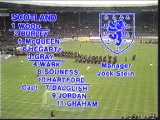 And ditto for the opposing team – in this case Scotland.
And ditto for the opposing team – in this case Scotland.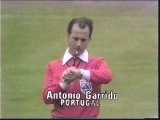 The referee (Antonio Garrido, from Portugal) was deemed important enough to have an on-screen caption all of his own. He checks his watch, waiting for play to begin.
The referee (Antonio Garrido, from Portugal) was deemed important enough to have an on-screen caption all of his own. He checks his watch, waiting for play to begin.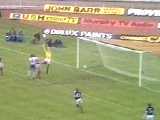 This (enlarged) view of the goal mouth shows some of the advertisement hoardings used at the time. Note the advertisements for Bush and Murphy – two electrical brand names that were prominent in the 1970s – the Bush brand is now owned by Sainsbury’s who own the chain of Argos catalogue shops in the UK and Ireland, amongst other concerns.
This (enlarged) view of the goal mouth shows some of the advertisement hoardings used at the time. Note the advertisements for Bush and Murphy – two electrical brand names that were prominent in the 1970s – the Bush brand is now owned by Sainsbury’s who own the chain of Argos catalogue shops in the UK and Ireland, amongst other concerns.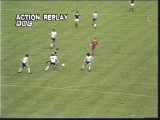 The advent of video disc recording in 1968 meant that action replays (including slow motion and still frames without any interference) were possible without any delay involved in rewinding a videotape, though this was confined only to the last 33 seconds of play which was being recorded in a continuous loop. The BBC showed briefly an onscreen caption (which included the BBC logo) at the beginning of the replay to let viewers know what they were watching; not long afterwards – well at least by January 1980 – this reminder was used far less often presumably because viewers had been long accustomed to this sort of thing.
The advent of video disc recording in 1968 meant that action replays (including slow motion and still frames without any interference) were possible without any delay involved in rewinding a videotape, though this was confined only to the last 33 seconds of play which was being recorded in a continuous loop. The BBC showed briefly an onscreen caption (which included the BBC logo) at the beginning of the replay to let viewers know what they were watching; not long afterwards – well at least by January 1980 – this reminder was used far less often presumably because viewers had been long accustomed to this sort of thing.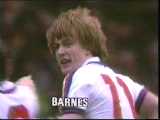 When something of note happened during the game (such as a goal being scored) a caption would often briefly appear identifying the person involved – in this case Peter Barnes who scored the equalising goal for England shortly before the half-time whistle.
When something of note happened during the game (such as a goal being scored) a caption would often briefly appear identifying the person involved – in this case Peter Barnes who scored the equalising goal for England shortly before the half-time whistle.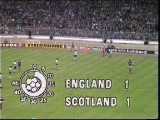 These were the days before the occasional use of a permanent on-screen display of the current score – viewers had to keep track of the game themselves for much of the time, in which case you had to be watching from the start or have a friend tell you the score. Hence this graphic was very important when it appeared – it also incorporated a football-shaped clock with a white band indicating elapsed time since the start of play.
These were the days before the occasional use of a permanent on-screen display of the current score – viewers had to keep track of the game themselves for much of the time, in which case you had to be watching from the start or have a friend tell you the score. Hence this graphic was very important when it appeared – it also incorporated a football-shaped clock with a white band indicating elapsed time since the start of play.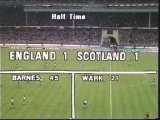 At the end of half (or full) time this noticeboard-style caption was used which helpfully gave details of who scored what goals and when. Also note the absence of any form of electronic scoreboard or large screen display(s) in the stadium which are so common today.
At the end of half (or full) time this noticeboard-style caption was used which helpfully gave details of who scored what goals and when. Also note the absence of any form of electronic scoreboard or large screen display(s) in the stadium which are so common today.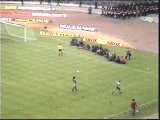 The marching band (a regular fixture during the interval to ‘entertain’ the crowd during and before this period) barely had the chance to leave the pitch when play started again!
The marching band (a regular fixture during the interval to ‘entertain’ the crowd during and before this period) barely had the chance to leave the pitch when play started again!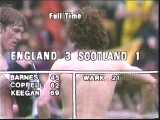 Match over – Ron Greenwood’s England team had beaten Jock Stein’s Scotland (something that wasn’t entirely expected) and the team captains (Dalglish and Keegan) swapped shirts.
Match over – Ron Greenwood’s England team had beaten Jock Stein’s Scotland (something that wasn’t entirely expected) and the team captains (Dalglish and Keegan) swapped shirts.
 The BBC (British Broadcasting Company, as it was known at the time) started the world’s first regular high definition – ‘high’ in this case being relative to what was technologically possible at the time – public television service at 3 p.m. on 2 November 1936, transmitting 405-line black-and-white pictures from Alexandra Palace (London) to an audience of less than 400 sets. The transmitter range was only 30 miles, and programming was very minimal to begin with – an hour in the afternoon and an hour in the evening, and nothing on Sundays until February 1938 – due to a lack of budget and studio facilities (only one studio available until 1938 when the second studio housing the Baird camera was recommissioned) and also due to early concerns about eye strain, though staring for long periods at a small flickering screen must have been difficult.
The BBC (British Broadcasting Company, as it was known at the time) started the world’s first regular high definition – ‘high’ in this case being relative to what was technologically possible at the time – public television service at 3 p.m. on 2 November 1936, transmitting 405-line black-and-white pictures from Alexandra Palace (London) to an audience of less than 400 sets. The transmitter range was only 30 miles, and programming was very minimal to begin with – an hour in the afternoon and an hour in the evening, and nothing on Sundays until February 1938 – due to a lack of budget and studio facilities (only one studio available until 1938 when the second studio housing the Baird camera was recommissioned) and also due to early concerns about eye strain, though staring for long periods at a small flickering screen must have been difficult. Lord Selsdon’s Committee, set up by the Postmaster General in 1935 had advised that the BBC should hold a public trial of the two systems proposed – Baird’s 240-line mechanical scanning system and Marconi-EMI’s 405-line electronic scanning system, so both systems were used on alternate weeks with each system’s equipment housed in separate 40 foot long studios. The Marconi-EMI system was so obviously superior in all respects that the Baird system was dropped by February 1937; Baird’s camera was fixed and required the subject to be specially lit, compared with Marconi-EMI’s cameras which could even be used outside with an extension lead. Baird had tried to overcome camera restrictions using an “intermediate film system” where celluloid film was rapidly processed and fed into an optical scanner, but it became fairly obvious that this cumbersome and expensive technique was merely a stop-gap compared to the Marconi-EMI system’s future potential.
Lord Selsdon’s Committee, set up by the Postmaster General in 1935 had advised that the BBC should hold a public trial of the two systems proposed – Baird’s 240-line mechanical scanning system and Marconi-EMI’s 405-line electronic scanning system, so both systems were used on alternate weeks with each system’s equipment housed in separate 40 foot long studios. The Marconi-EMI system was so obviously superior in all respects that the Baird system was dropped by February 1937; Baird’s camera was fixed and required the subject to be specially lit, compared with Marconi-EMI’s cameras which could even be used outside with an extension lead. Baird had tried to overcome camera restrictions using an “intermediate film system” where celluloid film was rapidly processed and fed into an optical scanner, but it became fairly obvious that this cumbersome and expensive technique was merely a stop-gap compared to the Marconi-EMI system’s future potential. Before World War 2 television was slow to catch on, largely due to the limited range of the transmissions, lack of programmes, and the cost of the receivers (£60 upwards) meant that typically only wealthy people could afford them, so programming was aimed generally at this audience; especially as the BBC itself was controlled by people from these affluent social groups.
Before World War 2 television was slow to catch on, largely due to the limited range of the transmissions, lack of programmes, and the cost of the receivers (£60 upwards) meant that typically only wealthy people could afford them, so programming was aimed generally at this audience; especially as the BBC itself was controlled by people from these affluent social groups. Television was still very much in its infancy when the service restarted in 1946. One set per street was common, and families often visited friends or relatives who had a set in order to watch events such as the Coronation in 1953. Also only two studios were available until 1949 when the BBC opened eight new West London studios (one ex-variety theatre and the rest were converted film studios).
Television was still very much in its infancy when the service restarted in 1946. One set per street was common, and families often visited friends or relatives who had a set in order to watch events such as the Coronation in 1953. Also only two studios were available until 1949 when the BBC opened eight new West London studios (one ex-variety theatre and the rest were converted film studios). After World War 2 a comprehensive transmitter building programme ensured more people outside heavy populated areas such as London could watch television, though it was slow to progress due to funding restrictions. In 1949 television reached the Midlands, Manchester in 1951, Scotland in 1952, then Wales and the West Country. Lack of signal coverage didn’t stop people living in ‘fringe’ areas putting up large aerials in an attempt to receive some form of television picture even if the end result was unwatchable from time to time due to nearby interference, even though for the first few post-war years television was heavily restricted to a small number of programmes each day, typically starting with a demonstration film in the morning and concluding with a news broadcast being relayed in sound only. Large gaps between programmes were very common, with interlude films or tuning signal captions being displayed between programmes.
After World War 2 a comprehensive transmitter building programme ensured more people outside heavy populated areas such as London could watch television, though it was slow to progress due to funding restrictions. In 1949 television reached the Midlands, Manchester in 1951, Scotland in 1952, then Wales and the West Country. Lack of signal coverage didn’t stop people living in ‘fringe’ areas putting up large aerials in an attempt to receive some form of television picture even if the end result was unwatchable from time to time due to nearby interference, even though for the first few post-war years television was heavily restricted to a small number of programmes each day, typically starting with a demonstration film in the morning and concluding with a news broadcast being relayed in sound only. Large gaps between programmes were very common, with interlude films or tuning signal captions being displayed between programmes. On December 2 1953, the BBC introduced a new symbol for use as visual identification (or an ident) for its Television Service, which quickly gained the nickname of “bat’s wings” due to its shape, and was the world’s first animated television ident symbol. Two ‘eyes’ rotated in the centre of a mechanical model whilst flashes of light shone on the wings at quarter-turn intervals; this was constructed as a mechanical model and the animation was filmed because the model was too fragile for regular use. The concept was developed by talented designer Abram Games, who was commissioned by the BBC on the strength of his emblem design for the Festival of Britain in 1951.
On December 2 1953, the BBC introduced a new symbol for use as visual identification (or an ident) for its Television Service, which quickly gained the nickname of “bat’s wings” due to its shape, and was the world’s first animated television ident symbol. Two ‘eyes’ rotated in the centre of a mechanical model whilst flashes of light shone on the wings at quarter-turn intervals; this was constructed as a mechanical model and the animation was filmed because the model was too fragile for regular use. The concept was developed by talented designer Abram Games, who was commissioned by the BBC on the strength of his emblem design for the Festival of Britain in 1951. Games also designed this clock as well as static cards featuring a simplified version of the same logo. Both the animated symbol and the clock remained in use until the end of 1959, but static captions featuring the symbol continued to be used until October 1960, whilst elements of the symbol (such as miniature lightning flashes) continued to be used for Schools programming until October 1961. During the mid-fifties, television was becoming more ambitious in terms of quantity and breadth, especially as post-war rationing was gradually coming to an end; programmes during this era included Mainly For Women, quiz show What’s My Line?, comedy series Emney Enterprises, drama serial The Grove Family, children’s favourite The Flowerpot Men and the groundbreaking six-part science fiction drama Quatermass and the Pit.
Games also designed this clock as well as static cards featuring a simplified version of the same logo. Both the animated symbol and the clock remained in use until the end of 1959, but static captions featuring the symbol continued to be used until October 1960, whilst elements of the symbol (such as miniature lightning flashes) continued to be used for Schools programming until October 1961. During the mid-fifties, television was becoming more ambitious in terms of quantity and breadth, especially as post-war rationing was gradually coming to an end; programmes during this era included Mainly For Women, quiz show What’s My Line?, comedy series Emney Enterprises, drama serial The Grove Family, children’s favourite The Flowerpot Men and the groundbreaking six-part science fiction drama Quatermass and the Pit.

 Television was starting to prove that the coverage of news and current events could combine the immediacy of a radio news report with visuals which were far more up-to-date than a cinema newsreel, even if news bulletins in particular were somewhat restricted in terms of what was achievable with the resources available to them. The use of still photographs to illustrate news stories (as opposed to moving pictures) was extremely commonplace, with regional news programmes in particular continuing with the practice into the 1980s primarily due to a lack of resources.
Television was starting to prove that the coverage of news and current events could combine the immediacy of a radio news report with visuals which were far more up-to-date than a cinema newsreel, even if news bulletins in particular were somewhat restricted in terms of what was achievable with the resources available to them. The use of still photographs to illustrate news stories (as opposed to moving pictures) was extremely commonplace, with regional news programmes in particular continuing with the practice into the 1980s primarily due to a lack of resources. The early post-war BBC news bulletins were often almost identical in format to the newsreels shown in cinemas, but competition from Independent Television News from 1955 onwards caused the BBC to adopt a more flexible presentation format for its bulletins. Shown here is Richard Baker presenting the 6pm news bulletin.
The early post-war BBC news bulletins were often almost identical in format to the newsreels shown in cinemas, but competition from Independent Television News from 1955 onwards caused the BBC to adopt a more flexible presentation format for its bulletins. Shown here is Richard Baker presenting the 6pm news bulletin. Post-war improvements in television technology meant that outside broadcasts of events such as horse racing were not only technically feasible but a wireless link meant that the action could be relayed back to the studios in real time from a moving vehicle for a truly live broadcast with no need to rush-process reels of film.
Post-war improvements in television technology meant that outside broadcasts of events such as horse racing were not only technically feasible but a wireless link meant that the action could be relayed back to the studios in real time from a moving vehicle for a truly live broadcast with no need to rush-process reels of film. The advent of video recording using magnetic tape in 1956 not only meant that programmes could now be easily recorded and reused, but also allowed for the recording of outdoor and indoor events for replaying at a more convenient time. Shown here is one of the first videotape recorders that was housed at the BBC’s Lime Grove studios; early videotapes were unreliable so the recording had to be replayed by a technician to check the quality of the recording before it was used for broadcast. Due to the high price of both the recorder and the tapes, the tapes were frequently wiped and reused after a programme had been shown or after a later repeat showing, therefore many programmes were not kept for posterity as a consequence unless they were judged to be of particular importance.
The advent of video recording using magnetic tape in 1956 not only meant that programmes could now be easily recorded and reused, but also allowed for the recording of outdoor and indoor events for replaying at a more convenient time. Shown here is one of the first videotape recorders that was housed at the BBC’s Lime Grove studios; early videotapes were unreliable so the recording had to be replayed by a technician to check the quality of the recording before it was used for broadcast. Due to the high price of both the recorder and the tapes, the tapes were frequently wiped and reused after a programme had been shown or after a later repeat showing, therefore many programmes were not kept for posterity as a consequence unless they were judged to be of particular importance. Video playback was particularly useful for the replay of sporting events such as horse racing, though good quality and immediate slow motion action replays had to wait for the invention of magnetic videodisc recording in 1968, and the replay time of these early disc recorders was limited to less than 30 seconds. Pictured here is the presenter of Sportsview, Peter Dimmock.
Video playback was particularly useful for the replay of sporting events such as horse racing, though good quality and immediate slow motion action replays had to wait for the invention of magnetic videodisc recording in 1968, and the replay time of these early disc recorders was limited to less than 30 seconds. Pictured here is the presenter of Sportsview, Peter Dimmock. Current affairs is a very important part of the schedule, and uses the medium of television to effectively cover the background to current news stories with a greater depth than is generally possible with a conventional news bulletin; here is Cliff Michelmore presenting an episode of Tonight. Other similar programmes include Panorama, which was (and still is) the BBC’s flagship current affairs programme that usually tackles a single topical issue in depth.
Current affairs is a very important part of the schedule, and uses the medium of television to effectively cover the background to current news stories with a greater depth than is generally possible with a conventional news bulletin; here is Cliff Michelmore presenting an episode of Tonight. Other similar programmes include Panorama, which was (and still is) the BBC’s flagship current affairs programme that usually tackles a single topical issue in depth. Dixon of Dock Green, with Jack Warner as PC Dixon was a long running police series that was rather old-fashioned in its approach even when it was first shown, but was popular nevertheless and lasted right up until 1976 when the competition (such as Z Cars and Softly Softly Task Force) started to make it look way past its “sell-by date”.
Dixon of Dock Green, with Jack Warner as PC Dixon was a long running police series that was rather old-fashioned in its approach even when it was first shown, but was popular nevertheless and lasted right up until 1976 when the competition (such as Z Cars and Softly Softly Task Force) started to make it look way past its “sell-by date”. The increase in viewers combined with competition from ITV by 1955 lead to new programme ideas being explored. From 1956 onwards, Barry Bucknell (pictured here) presented do-it-yourself projects on television, firstly as a contributor to About The Home which was then followed by his own series, entitled Barry Bucknell’s Do It Yourself. Just like many contemporaneous studio-based productions, this was broadcast live, resulting in the occasional (and inevitable) on-screen mishap. He then went on to present the much more ambitious house renovation programme Bucknell’s House in 1962, featuring a house in Ealing bought for £2,250. This area of programming was relatively neglected during the following decades until the advent of Changing Rooms in 1994, though there was On the House shown in the mid 1980s.
The increase in viewers combined with competition from ITV by 1955 lead to new programme ideas being explored. From 1956 onwards, Barry Bucknell (pictured here) presented do-it-yourself projects on television, firstly as a contributor to About The Home which was then followed by his own series, entitled Barry Bucknell’s Do It Yourself. Just like many contemporaneous studio-based productions, this was broadcast live, resulting in the occasional (and inevitable) on-screen mishap. He then went on to present the much more ambitious house renovation programme Bucknell’s House in 1962, featuring a house in Ealing bought for £2,250. This area of programming was relatively neglected during the following decades until the advent of Changing Rooms in 1994, though there was On the House shown in the mid 1980s. Grandstand was the name of the BBC’s long-running sports magazine programme that was broadcast between 1958 and 2007, mainly on Saturday afternoons when much of the sporting action took place. Peter Dimmock presented the first three programmes but David Coleman then took over the role of presenter who was followed by Frank Bough, Des Lynam, Steve Rider and a slew of guest presenters during its final years up until Grandstand‘s final broadcasts during the last weekend of January 2007. It was most likely axed because the BBC now had fewer rights to broadcast sport than it did in the past due to increased competition from other broadcasters; notably pay-TV sport channels provided by broadcasters like BSkyB and BT.
Grandstand was the name of the BBC’s long-running sports magazine programme that was broadcast between 1958 and 2007, mainly on Saturday afternoons when much of the sporting action took place. Peter Dimmock presented the first three programmes but David Coleman then took over the role of presenter who was followed by Frank Bough, Des Lynam, Steve Rider and a slew of guest presenters during its final years up until Grandstand‘s final broadcasts during the last weekend of January 2007. It was most likely axed because the BBC now had fewer rights to broadcast sport than it did in the past due to increased competition from other broadcasters; notably pay-TV sport channels provided by broadcasters like BSkyB and BT.

 The above images illustrate the style of programme promotion used circa 1960, with its contemporary style and bold graphics replacing the Abram Games-designed “bat’s wings” symbol; elements of the new design had been introduced during 1959 prior to its formal introduction in 1960. Note the “BBC tv” italic letters appearing in separate square boxes similar to the modern BBC logo style, and the clock kept the unusually long second hand previously used for the “bat’s wing” clock. However this presentation style didn’t last nearly as long as the Abram Games symbol, with the introduction of the first of a succession of various globe symbols used to identify BBC Television soon to follow together with changes in style for the BBC corporate logo.
The above images illustrate the style of programme promotion used circa 1960, with its contemporary style and bold graphics replacing the Abram Games-designed “bat’s wings” symbol; elements of the new design had been introduced during 1959 prior to its formal introduction in 1960. Note the “BBC tv” italic letters appearing in separate square boxes similar to the modern BBC logo style, and the clock kept the unusually long second hand previously used for the “bat’s wing” clock. However this presentation style didn’t last nearly as long as the Abram Games symbol, with the introduction of the first of a succession of various globe symbols used to identify BBC Television soon to follow together with changes in style for the BBC corporate logo. With television now rapidly becoming the dominant broadcasting medium in the UK, the BBC needed somewhere that was much bigger than Alexandra Palace to accommodate its production requirements, therefore a new headquarters known as BBC Television Centre was commissioned and built on a suitable site in West London, with construction commencing in 1952 and Television Centre was ready for use by June 1960. From the air, the Television Centre buildings appear to take on the shape of a question mark, because that layout was thought to be best for the site in general.
With television now rapidly becoming the dominant broadcasting medium in the UK, the BBC needed somewhere that was much bigger than Alexandra Palace to accommodate its production requirements, therefore a new headquarters known as BBC Television Centre was commissioned and built on a suitable site in West London, with construction commencing in 1952 and Television Centre was ready for use by June 1960. From the air, the Television Centre buildings appear to take on the shape of a question mark, because that layout was thought to be best for the site in general. The BBC naturally wanted to show off its new Television Centre building to its viewers, so a special light entertainment programme was shown on 29 June 1960 in order to do just that, logically entitled First Night. Not all of the BBC’s departments moved into the new building straightaway, with (for example) the News division not moving into Television Centre until 1969. The Open University was to make use of otherwise-unused Alexandra Palace studio facilities from 1970 onwards.
The BBC naturally wanted to show off its new Television Centre building to its viewers, so a special light entertainment programme was shown on 29 June 1960 in order to do just that, logically entitled First Night. Not all of the BBC’s departments moved into the new building straightaway, with (for example) the News division not moving into Television Centre until 1969. The Open University was to make use of otherwise-unused Alexandra Palace studio facilities from 1970 onwards.

 The introduction of BBC2 in 1964, which enabled extra programmes which were not necessarily of mass appeal to be shown, and eventually colour was introduced to (what was now known as) BBC1 by the end of the decade. Some very memorable and ground-breaking programmes were being produced during this period which are still being shown around the world today, such as Steptoe and Son, and the long-running Doctor Who series began. Other programmes shown during the late 1960s included the popular sitcom Beggar My Neighbour, soap The Newcomers and football club drama United.
The introduction of BBC2 in 1964, which enabled extra programmes which were not necessarily of mass appeal to be shown, and eventually colour was introduced to (what was now known as) BBC1 by the end of the decade. Some very memorable and ground-breaking programmes were being produced during this period which are still being shown around the world today, such as Steptoe and Son, and the long-running Doctor Who series began. Other programmes shown during the late 1960s included the popular sitcom Beggar My Neighbour, soap The Newcomers and football club drama United. The weather forecast had progressed from the use of hand-drawn maps to the use of magnetic symbols by the mid-1960s as shown here, and this style of map continued to be used for several years after BBC1 had started broadcasting in colour in 1969. Before the use of magnetic symbols, everything had to be hand-drawn which was a time-consuming practice as well as being rather inflexible; the whole map obviously had to be redrawn if a correction was required.
The weather forecast had progressed from the use of hand-drawn maps to the use of magnetic symbols by the mid-1960s as shown here, and this style of map continued to be used for several years after BBC1 had started broadcasting in colour in 1969. Before the use of magnetic symbols, everything had to be hand-drawn which was a time-consuming practice as well as being rather inflexible; the whole map obviously had to be redrawn if a correction was required. Despite BBC1 getting the go-ahead to start a colour service in 1969, the regional centres were inevitably slower to upgrade all of their equipment to provide a colour service due to cost reasons, and it was several months before Television Centre was fully colour-equipped. The news magazine programme Nationwide incorporating reports and features from the various regions also started in this particular year, and some of the regional contributions weren’t produced in colour until the end of the 1970s. (Inside Out is perhaps the modern spiritual successor to Nationwide even if The One Show has a similar mix of features and studio discussion pieces.)
Despite BBC1 getting the go-ahead to start a colour service in 1969, the regional centres were inevitably slower to upgrade all of their equipment to provide a colour service due to cost reasons, and it was several months before Television Centre was fully colour-equipped. The news magazine programme Nationwide incorporating reports and features from the various regions also started in this particular year, and some of the regional contributions weren’t produced in colour until the end of the 1970s. (Inside Out is perhaps the modern spiritual successor to Nationwide even if The One Show has a similar mix of features and studio discussion pieces.) 1972 was the 50th anniversary of the BBC, though at that time less than 20% of viewers had a colour television despite a colour service being available on all three channels since 1969; the BBC’s summer Olympic Games coverage did however help to boost colour television sales during 1972. Notable BBC1 programmes broadcast during the early 1970s included Bruce Forsyth and the Generation Game (its initial title) which started in 1971, science fiction drama Moonbase 3, drama series Owen, M.D., plus the popular sitcoms Are You Being Served? and the very long-running Last Of The Summer Wine began in 1972.
1972 was the 50th anniversary of the BBC, though at that time less than 20% of viewers had a colour television despite a colour service being available on all three channels since 1969; the BBC’s summer Olympic Games coverage did however help to boost colour television sales during 1972. Notable BBC1 programmes broadcast during the early 1970s included Bruce Forsyth and the Generation Game (its initial title) which started in 1971, science fiction drama Moonbase 3, drama series Owen, M.D., plus the popular sitcoms Are You Being Served? and the very long-running Last Of The Summer Wine began in 1972. By the mid 1970s most families had at least one television set, and nearly all of the populated regions of the British Isles could receive television pictures in some form even if it was only a 405-line monochrome signal. Sitcoms and studio-based light entertainment were of extremely high quality during this period, with many classic programmes produced including It Ain’t Half Hot Mum, Some Mothers Do ‘Ave ‘Em, The Good Life and The Liver Birds. The Two Ronnies, The Morecambe and Wise Show and The Mike Yarwood Show featured in what many people now consider to be the BBC’s greatest ever Christmas Day schedule in 1977.
By the mid 1970s most families had at least one television set, and nearly all of the populated regions of the British Isles could receive television pictures in some form even if it was only a 405-line monochrome signal. Sitcoms and studio-based light entertainment were of extremely high quality during this period, with many classic programmes produced including It Ain’t Half Hot Mum, Some Mothers Do ‘Ave ‘Em, The Good Life and The Liver Birds. The Two Ronnies, The Morecambe and Wise Show and The Mike Yarwood Show featured in what many people now consider to be the BBC’s greatest ever Christmas Day schedule in 1977. The Basil Brush Show started life as a children’s programme in 1968, showing on Thursdays just before the early evening news, but by the mid-1970s it had moved to an early Saturday evening slot and was now a very popular mainstream family entertainment show, featuring top singing stars like Cilla Black, Demis Roussos and Petula Clark that often did a comedy duet with fox puppet Basil as well as singing on their own. Basil is shown here with Roy North, who became Basil’s human sidekick in 1976.
The Basil Brush Show started life as a children’s programme in 1968, showing on Thursdays just before the early evening news, but by the mid-1970s it had moved to an early Saturday evening slot and was now a very popular mainstream family entertainment show, featuring top singing stars like Cilla Black, Demis Roussos and Petula Clark that often did a comedy duet with fox puppet Basil as well as singing on their own. Basil is shown here with Roy North, who became Basil’s human sidekick in 1976. Angels was a popular drama series set in a fictional (St. Angela’s) hospital, and is just one example of the BBC’s prodigious drama output from the 1970s. Indeed Angels survived until the early 1980s and was the spiritual predecessor to Casualty (which started in 1986) and its later spin-off Holby City which are now shown on a regular basis. Other drama offerings from this period included historical drama I, Claudius, and science fiction series Blake’s 7 began in 1978.
Angels was a popular drama series set in a fictional (St. Angela’s) hospital, and is just one example of the BBC’s prodigious drama output from the 1970s. Indeed Angels survived until the early 1980s and was the spiritual predecessor to Casualty (which started in 1986) and its later spin-off Holby City which are now shown on a regular basis. Other drama offerings from this period included historical drama I, Claudius, and science fiction series Blake’s 7 began in 1978.


 Pictured is what a typical BBC News bulletin looked like in 1978, with Angela Rippon being the newsreader. There was still a predominance of photographs used during this period as opposed to the video clips that typify modern news bulletins, though national news bulletins were steadily becoming more sophisticated in their visual presentation.
Pictured is what a typical BBC News bulletin looked like in 1978, with Angela Rippon being the newsreader. There was still a predominance of photographs used during this period as opposed to the video clips that typify modern news bulletins, though national news bulletins were steadily becoming more sophisticated in their visual presentation. Here’s an example of a BBC1 Saturday evening programme schedule as broadcast on 14 April 1979. At this point virtually all new programmes were now being produced in colour, though there were still a significant number of people that didn’t have colour televisions; 1976 being the year when colour TV licences outnumbered those issued for black and white. 1979 also saw the broadcast of what was the most ambitious natural history series commissioned up to that point, namely Life on Earth, presented by David Attenborough.
Here’s an example of a BBC1 Saturday evening programme schedule as broadcast on 14 April 1979. At this point virtually all new programmes were now being produced in colour, though there were still a significant number of people that didn’t have colour televisions; 1976 being the year when colour TV licences outnumbered those issued for black and white. 1979 also saw the broadcast of what was the most ambitious natural history series commissioned up to that point, namely Life on Earth, presented by David Attenborough. Blankety Blank was a popular BBC quiz show which was first presented by Terry Wogan (famous for having his long stick microphone bent by Kenny Everett), but was later presented by Les Dawson. Then the series was revived with Lilly Savage at the helm, followed by ITV giving the idea a brief revival itself but none of these revivals matched the popularity of the original series.
Blankety Blank was a popular BBC quiz show which was first presented by Terry Wogan (famous for having his long stick microphone bent by Kenny Everett), but was later presented by Les Dawson. Then the series was revived with Lilly Savage at the helm, followed by ITV giving the idea a brief revival itself but none of these revivals matched the popularity of the original series. 1982 was the 60th anniversary of the BBC, and the “60 BBC Years” slogan was also used at the bottom of the BBC1 globe ident for a while as part of the celebrations. September that same year also saw the introduction of a new light entertainment series: The Late, Late Breakfast Show, which featured a selection of occasionally dangerous stunts performed by members of the public in the “Give It A Whirl” slot that resulted in several injuries and a death that caused the show to be cancelled in 1986. The Late-Late Breakfast Show was presented by Noel Edmonds who at that point was famous for presenting breakfast shows both on the radio and Swap Shop on BBC1, hence the tongue-in-cheek title.
1982 was the 60th anniversary of the BBC, and the “60 BBC Years” slogan was also used at the bottom of the BBC1 globe ident for a while as part of the celebrations. September that same year also saw the introduction of a new light entertainment series: The Late, Late Breakfast Show, which featured a selection of occasionally dangerous stunts performed by members of the public in the “Give It A Whirl” slot that resulted in several injuries and a death that caused the show to be cancelled in 1986. The Late-Late Breakfast Show was presented by Noel Edmonds who at that point was famous for presenting breakfast shows both on the radio and Swap Shop on BBC1, hence the tongue-in-cheek title. 1982 was also the year of the Falklands War, with the BBC naturally devoting significant coverage to this particular news story allowing for the limitations of war reporting. Also the raising of the wreck of the Mary Rose was shown live on television in the same year.
1982 was also the year of the Falklands War, with the BBC naturally devoting significant coverage to this particular news story allowing for the limitations of war reporting. Also the raising of the wreck of the Mary Rose was shown live on television in the same year. The start of 1983 heralded the launch of breakfast television, with the BBC getting in first with their Breakfast Time before the new TV-am ITV franchise started over on Channel 3. Frank Bough and the team turned out to be just what the nation was waiting for in terms of breakfast television in the morning, and the new TV-am got off to a bad start to the day as a consequence.
The start of 1983 heralded the launch of breakfast television, with the BBC getting in first with their Breakfast Time before the new TV-am ITV franchise started over on Channel 3. Frank Bough and the team turned out to be just what the nation was waiting for in terms of breakfast television in the morning, and the new TV-am got off to a bad start to the day as a consequence. By January 1985 the old 405-line VHF network had completely closed down, and a full daytime television schedule launched in 1986 that included Neighbours, the Australian soap opera which is still being shown on Channel 5. By 1989 the BBC and other broadcasters also faced competition from the newly-emerging satellite services (Sky and BSB, with Sky eventually taking over BSB to form BSkyB). Pictured is an example of what a Saturday evening’s viewing on BBC1 looked like on the 6th of June 1987.
By January 1985 the old 405-line VHF network had completely closed down, and a full daytime television schedule launched in 1986 that included Neighbours, the Australian soap opera which is still being shown on Channel 5. By 1989 the BBC and other broadcasters also faced competition from the newly-emerging satellite services (Sky and BSB, with Sky eventually taking over BSB to form BSkyB). Pictured is an example of what a Saturday evening’s viewing on BBC1 looked like on the 6th of June 1987.


 This graphic style used for BBC News has the nickname of “Star Wars” due to the logo appearing to be constructed in space using a beam of light; it certainly seemed to match the mood of the period in terms of its drama and pomposity.
This graphic style used for BBC News has the nickname of “Star Wars” due to the logo appearing to be constructed in space using a beam of light; it certainly seemed to match the mood of the period in terms of its drama and pomposity. The 1980s was also the era of the video cassette recorder or ‘VCR’; although such devices were available in the 1970s (and earlier) it was this decade that saw them become widely available and (by 1987) inexpensive thanks to the aggressive pricing of Far Eastern-produced machines such as Amstrad. Teletext became commonplace on more expensive sets and included on some of the cheaper ones too, and Nicam stereo sound was introduced towards the end of the decade, initially from certain transmitters only.
The 1980s was also the era of the video cassette recorder or ‘VCR’; although such devices were available in the 1970s (and earlier) it was this decade that saw them become widely available and (by 1987) inexpensive thanks to the aggressive pricing of Far Eastern-produced machines such as Amstrad. Teletext became commonplace on more expensive sets and included on some of the cheaper ones too, and Nicam stereo sound was introduced towards the end of the decade, initially from certain transmitters only. All smoke and mirrors? The globe above was replaced with this smoky light reflecting version in 1991, together with the return of the 1960s typeface. The word ‘Stereo’ appeared in the top-left hand corner when a programme with a stereo soundtrack followed – BBC1 was the last established UK channel to formally introduce Nicam stereo, which it did in September 1991, but not all major transmitters had been upgraded to carry the digital signal from day one.
All smoke and mirrors? The globe above was replaced with this smoky light reflecting version in 1991, together with the return of the 1960s typeface. The word ‘Stereo’ appeared in the top-left hand corner when a programme with a stereo soundtrack followed – BBC1 was the last established UK channel to formally introduce Nicam stereo, which it did in September 1991, but not all major transmitters had been upgraded to carry the digital signal from day one. The change from a globe to a balloon (albeit with a globe pattern) came at the same time as the BBC changed its onscreen font to Gill Sans in October 1997, which was part of Martin Lambie-Nairn’s corporate vision for the BBC. The adoption of Gill Sans was something that was both traditional and forward-thinking in terms of looking better when displayed in the new widescreen format and when decompressed from a digitally-compressed datastream compared with the old sloping rhombus typeface that dates back to the 1960s. A variety of short video clips are used featuring the BBC balloon in different locations around the British Isles (above a castle, behind a suspension bridge, etc.), meaning that the balloon usually had a different ‘view’ before each programme as opposed to the essentially static backdrop that the globe had.
The change from a globe to a balloon (albeit with a globe pattern) came at the same time as the BBC changed its onscreen font to Gill Sans in October 1997, which was part of Martin Lambie-Nairn’s corporate vision for the BBC. The adoption of Gill Sans was something that was both traditional and forward-thinking in terms of looking better when displayed in the new widescreen format and when decompressed from a digitally-compressed datastream compared with the old sloping rhombus typeface that dates back to the 1960s. A variety of short video clips are used featuring the BBC balloon in different locations around the British Isles (above a castle, behind a suspension bridge, etc.), meaning that the balloon usually had a different ‘view’ before each programme as opposed to the essentially static backdrop that the globe had.







 Also launched at the same time as the new corporate look for the BBC was perhaps the most successful UK TV-based promotion of all time; it was based around a simple concept, namely that the BBC offers a huge variety of different types of music, catering for almost every taste on its numerous radio and television services.
Also launched at the same time as the new corporate look for the BBC was perhaps the most successful UK TV-based promotion of all time; it was based around a simple concept, namely that the BBC offers a huge variety of different types of music, catering for almost every taste on its numerous radio and television services. Set to the soundtrack of Perfect Day, a song originally performed by Lou Reed who also appears amongst the numerous celebrities who both take it in turns to sing and appear on screen, with a slide projector showing various images interspersed with the celebrities. Also note the thin black bars appearing at the top and bottom of the pictures, indicating that it was one of the first BBC productions to be produced in widescreen format, though the widescreen format was only formally introduced with the introduction of digital widescreen broadcasting the following year.
Set to the soundtrack of Perfect Day, a song originally performed by Lou Reed who also appears amongst the numerous celebrities who both take it in turns to sing and appear on screen, with a slide projector showing various images interspersed with the celebrities. Also note the thin black bars appearing at the top and bottom of the pictures, indicating that it was one of the first BBC productions to be produced in widescreen format, though the widescreen format was only formally introduced with the introduction of digital widescreen broadcasting the following year. This version of Perfect Day was released as a charity record and sold more than a million copies in the UK, reaching Number 1 in the singles chart and most likely to have been a major factor in the popularity of this particular promotion, though it has to be said that the promotion itself was exquisitely produced and directed therefore is essentially a work of art in its own right.
This version of Perfect Day was released as a charity record and sold more than a million copies in the UK, reaching Number 1 in the singles chart and most likely to have been a major factor in the popularity of this particular promotion, though it has to be said that the promotion itself was exquisitely produced and directed therefore is essentially a work of art in its own right. March 2002 saw a radical new look introduced for BBC One; the main channel logo now appears in a box just like the BBC Two logo, but more controversially the globe as a centrepiece has now been banished to the history books, and instead various sequences using dance as a theme have been introduced. The whole emphasis was to introduce a modern multicultural ‘feel’ to the channel, but whether the identity of the channel had been diluted as a result is open to debate, especially as the channel’s presentation package only lasted four years before being replaced by something else.
March 2002 saw a radical new look introduced for BBC One; the main channel logo now appears in a box just like the BBC Two logo, but more controversially the globe as a centrepiece has now been banished to the history books, and instead various sequences using dance as a theme have been introduced. The whole emphasis was to introduce a modern multicultural ‘feel’ to the channel, but whether the identity of the channel had been diluted as a result is open to debate, especially as the channel’s presentation package only lasted four years before being replaced by something else. Several programming ideas were tried in 2004 with mixed results; Test your Pet, presumably intended to be educational in relation to animal training but ended up being closer in spirit to to the somewhat infamous but fun Pets Win Prizes. As well as testing pets, humans were equally tested in Come and Have a Go… If You Think You’re Smart Enough, consumer issues were aired in the short-lived Brassed Off Britain, detective drama Murphy’s Law received an airing but something rather more enduring also debuted soon afterwards – Strictly Come Dancing, a dance competition show which rapidly became very popular and continues to this day. And the following year saw the rejuvenation of an old idea which also proved to be just as popular.
Several programming ideas were tried in 2004 with mixed results; Test your Pet, presumably intended to be educational in relation to animal training but ended up being closer in spirit to to the somewhat infamous but fun Pets Win Prizes. As well as testing pets, humans were equally tested in Come and Have a Go… If You Think You’re Smart Enough, consumer issues were aired in the short-lived Brassed Off Britain, detective drama Murphy’s Law received an airing but something rather more enduring also debuted soon afterwards – Strictly Come Dancing, a dance competition show which rapidly became very popular and continues to this day. And the following year saw the rejuvenation of an old idea which also proved to be just as popular. By 2005 Lorraine Heggessey had been replaced by Peter Fincham as controller of BBC One, and the general consensus was that Heggessey had left the channel in a relatively strong position in terms of its drama output with a newly rejuvenated Doctor Who alongside other popular series like New Tricks, proving that it is still possible to have a drama series that appeals to the whole family, though the channel was criticised in the BBC Annual Report for perhaps running too many repeats in peak time. Hustle and A Picture of Britain were other examples of popular programmes, plus The Kumars at No 42 being an example of a programme transferred from BBC Two to BBC One.
By 2005 Lorraine Heggessey had been replaced by Peter Fincham as controller of BBC One, and the general consensus was that Heggessey had left the channel in a relatively strong position in terms of its drama output with a newly rejuvenated Doctor Who alongside other popular series like New Tricks, proving that it is still possible to have a drama series that appeals to the whole family, though the channel was criticised in the BBC Annual Report for perhaps running too many repeats in peak time. Hustle and A Picture of Britain were other examples of popular programmes, plus The Kumars at No 42 being an example of a programme transferred from BBC Two to BBC One. August 2006 saw the first four week trial run of The ONE Show, but its debut had notable differences compared to what the series became when it returned as an (almost) regular fixture of early weekday evenings on BBC One starting from July 2007, notably a different co-presenter alongside Adrian Chiles (Nadia Sawalha), plus a different title sequence with different music as well as the studio being based in Birmingham (the studio overlooked a canal).
August 2006 saw the first four week trial run of The ONE Show, but its debut had notable differences compared to what the series became when it returned as an (almost) regular fixture of early weekday evenings on BBC One starting from July 2007, notably a different co-presenter alongside Adrian Chiles (Nadia Sawalha), plus a different title sequence with different music as well as the studio being based in Birmingham (the studio overlooked a canal). During the 2006 trial there was a more formal use of a map showing different UK locations where each regional feature originated from. The ONE Show was thought of by some people as being a spiritual successor to Nationwide, but this was perhaps more the case for the trial run with its map-based presentation as opposed to the revamped final version which had essentially become just a succession of studio-linked features.
During the 2006 trial there was a more formal use of a map showing different UK locations where each regional feature originated from. The ONE Show was thought of by some people as being a spiritual successor to Nationwide, but this was perhaps more the case for the trial run with its map-based presentation as opposed to the revamped final version which had essentially become just a succession of studio-linked features. The ONE Show‘s trial run was judged to have been a success but several changes were made including the moderately controversial step of moving the show’s studio base to London as well as employing Christine Bleakley as a co-presenter since Sawalha was no longer available, though both Chiles and Bleakley were later lured by ITV in order to head up their new GMTV replacement, Daybreak, but that didn’t work out as expected therefore both are now employed on different projects within ITV productions. (Chiles was and still is noted for his football punditry.)
The ONE Show‘s trial run was judged to have been a success but several changes were made including the moderately controversial step of moving the show’s studio base to London as well as employing Christine Bleakley as a co-presenter since Sawalha was no longer available, though both Chiles and Bleakley were later lured by ITV in order to head up their new GMTV replacement, Daybreak, but that didn’t work out as expected therefore both are now employed on different projects within ITV productions. (Chiles was and still is noted for his football punditry.) Also included immediately after The ONE Show during its 2006 trial was a short regional news opt-out billed as an “news update”; illustrated here is the BBC North West Tonight News Update, presented by Gordon Burns who has now retired and been replaced by Roger Johnson (ex-BBC South Today).
Also included immediately after The ONE Show during its 2006 trial was a short regional news opt-out billed as an “news update”; illustrated here is the BBC North West Tonight News Update, presented by Gordon Burns who has now retired and been replaced by Roger Johnson (ex-BBC South Today). What comes around…The dance and movement idents were inevitably replaced by new idents in 2006, and Red Bee Media had been contracted to produce their replacement. For inspiration they looked at some of the early 1950s BBC Television Service idents which inevitably used some form of circle as part of a tuning signal for viewers to adjust their TV sets, and everything from the Abram Games “bat’s wing” symbol to the later globes also featured a circle as part of their design, so Red Bee proposed that a new identity theme should be based around the concept of circles. New idents were produced which featured real life circular elements such as hippos, surfers, dancing children and the moon, plus the channel logo was given a new and bolder treatment. A circle signifies ‘togetherness’ in the eyes of the branding consultants, but whether viewers actually made the connection remained to be seen.
What comes around…The dance and movement idents were inevitably replaced by new idents in 2006, and Red Bee Media had been contracted to produce their replacement. For inspiration they looked at some of the early 1950s BBC Television Service idents which inevitably used some form of circle as part of a tuning signal for viewers to adjust their TV sets, and everything from the Abram Games “bat’s wing” symbol to the later globes also featured a circle as part of their design, so Red Bee proposed that a new identity theme should be based around the concept of circles. New idents were produced which featured real life circular elements such as hippos, surfers, dancing children and the moon, plus the channel logo was given a new and bolder treatment. A circle signifies ‘togetherness’ in the eyes of the branding consultants, but whether viewers actually made the connection remained to be seen. The second series of the critically-acclaimed drama Life On Mars (about a policeman who thinks that he’s living in 1973) was shown on BBC One and repeated on BBC Four during February and March of 2007. Red Bee Media was given the contract to produce promotional material for this series, and the end result was an imaginative collection of various items such as bus shelter posters and promotional clips which had been given a retro 1970s-style treatment.
The second series of the critically-acclaimed drama Life On Mars (about a policeman who thinks that he’s living in 1973) was shown on BBC One and repeated on BBC Four during February and March of 2007. Red Bee Media was given the contract to produce promotional material for this series, and the end result was an imaginative collection of various items such as bus shelter posters and promotional clips which had been given a retro 1970s-style treatment. Plus each episode of Life On Mars on BBC One began with a widescreen recreation of the style of globe ident that was in use during this era, whilst viewers in Wales were treated to a different, genuine mechanical globe complete with a voiceover provided by a continuity announcer who had worked during the early-’70s period. (Though BBC Wales didn’t actually use this type of globe until 1974.)
Plus each episode of Life On Mars on BBC One began with a widescreen recreation of the style of globe ident that was in use during this era, whilst viewers in Wales were treated to a different, genuine mechanical globe complete with a voiceover provided by a continuity announcer who had worked during the early-’70s period. (Though BBC Wales didn’t actually use this type of globe until 1974.) Other BBC One programmes in 2007 included the rather ambitious series Andrew Marr’s History of Modern Britain which attempted to cover a huge subject in five programmes broadcast between 22 May and 19 June, and its critical success resulted in a follow-up series entitled Andrew Marr’s The Making of Modern Britain.
Other BBC One programmes in 2007 included the rather ambitious series Andrew Marr’s History of Modern Britain which attempted to cover a huge subject in five programmes broadcast between 22 May and 19 June, and its critical success resulted in a follow-up series entitled Andrew Marr’s The Making of Modern Britain. 2010 saw a General Election in which a coalition government was returned, given no overall majority in the House of Commons. The BBC was on-hand to provide its comprehensive results service as is normal for such occasions, with its BBC News channel also providing rolling coverage once the main programme had drawn to a close.
2010 saw a General Election in which a coalition government was returned, given no overall majority in the House of Commons. The BBC was on-hand to provide its comprehensive results service as is normal for such occasions, with its BBC News channel also providing rolling coverage once the main programme had drawn to a close. The first major department to move from London’s Television Centre to MediaCityUK in Salford Quays was children’s television, with the Blue Peter garden following Blue Peter to its new Salford home and is now a rooftop garden. This picture is taken from the very first Blue Peter to be broadcast from Salford, with the two regular presenters arriving via dramatic means – Helen Skelton by helicopter and Barney Harwood by jet ski.
The first major department to move from London’s Television Centre to MediaCityUK in Salford Quays was children’s television, with the Blue Peter garden following Blue Peter to its new Salford home and is now a rooftop garden. This picture is taken from the very first Blue Peter to be broadcast from Salford, with the two regular presenters arriving via dramatic means – Helen Skelton by helicopter and Barney Harwood by jet ski.

 2012 was certainly a busy year for the BBC in terms of large public events; firstly there was the Queen’s Diamond Jubilee with its associated river pageant and concert to cover as well as the London Olympic Games later in the year. The BBC’s coverage of the pageant was, however, not one of its finest moments due to several technical problems meaning that many of the planned live links with boats taking part in the pageant had to be cancelled, inevitably resulting in land-based presenters such as Fearne Cotton being left with the task of filling in much more frequently than originally intended.
2012 was certainly a busy year for the BBC in terms of large public events; firstly there was the Queen’s Diamond Jubilee with its associated river pageant and concert to cover as well as the London Olympic Games later in the year. The BBC’s coverage of the pageant was, however, not one of its finest moments due to several technical problems meaning that many of the planned live links with boats taking part in the pageant had to be cancelled, inevitably resulting in land-based presenters such as Fearne Cotton being left with the task of filling in much more frequently than originally intended. Thankfully the BBC’s coverage of the Diamond Jubilee concert went much more smoothly, even if there were a few complaints about concert sound quality from some viewers. Various big-name acts took to the stage, including Stevie Wonder, Annie Lennox, Robbie Williams, Tom Jones, Sir Cliff Richard, Grace Jones doing a highly memorable routine with a hula hoop to Slave to the Rhythm, and Madness performing on top of Buckingham Palace whilst various images were being projected on the front of the building. The end result was a concert which was watched by an average of nearly 15 million viewers.
Thankfully the BBC’s coverage of the Diamond Jubilee concert went much more smoothly, even if there were a few complaints about concert sound quality from some viewers. Various big-name acts took to the stage, including Stevie Wonder, Annie Lennox, Robbie Williams, Tom Jones, Sir Cliff Richard, Grace Jones doing a highly memorable routine with a hula hoop to Slave to the Rhythm, and Madness performing on top of Buckingham Palace whilst various images were being projected on the front of the building. The end result was a concert which was watched by an average of nearly 15 million viewers.

 Once in a lifetime…The London 2012 Olympic Games promised the biggest sporting spectacle the UK had ever seen, therefore it was the BBC’s obligation to provide the best and most comprehensive coverage possible for its viewers. Indeed the BBC devoted a very significant chunk of its resources to the Games as a consequence, which included an extra HD TV channel for digital terrestrial (Freeview) viewers, 30 additional HD channels for viewing via satellite, cable or online plus other radio and online resources. It wasn’t surprising therefore that an elaborate animated promotion was commissioned to promote the BBC’s wide-ranging coverage of such a major event.
Once in a lifetime…The London 2012 Olympic Games promised the biggest sporting spectacle the UK had ever seen, therefore it was the BBC’s obligation to provide the best and most comprehensive coverage possible for its viewers. Indeed the BBC devoted a very significant chunk of its resources to the Games as a consequence, which included an extra HD TV channel for digital terrestrial (Freeview) viewers, 30 additional HD channels for viewing via satellite, cable or online plus other radio and online resources. It wasn’t surprising therefore that an elaborate animated promotion was commissioned to promote the BBC’s wide-ranging coverage of such a major event. Shown on BBC1, BBC One HD and also on the BBC HD channel in 3D, the London 2012 Olympics Opening Ceremony was watched by a peak of 27 million viewers; that’s roughly half the population of the UK tuning in to watch at least some of the ceremony’s live coverage. Danny Boyle was responsible for producing and directing the ceremony’s elaborate routines, set design and special effects that culminated in the lighting of the Olympic cauldron by eight promising young athletes using the Olympic torch that had previously been carried around the UK by various selected individuals over the previous weeks.
Shown on BBC1, BBC One HD and also on the BBC HD channel in 3D, the London 2012 Olympics Opening Ceremony was watched by a peak of 27 million viewers; that’s roughly half the population of the UK tuning in to watch at least some of the ceremony’s live coverage. Danny Boyle was responsible for producing and directing the ceremony’s elaborate routines, set design and special effects that culminated in the lighting of the Olympic cauldron by eight promising young athletes using the Olympic torch that had previously been carried around the UK by various selected individuals over the previous weeks. Despite recent distractions such as the aforementioned Olympics and Diamond Jubilee as well as the upheaval of moving staff and equipment out of Television Centre prior to its redevelopment, BBC One as a channel has continued to be a strong performer in terms of popular entertainment, factual programming, drama and comedy, with shows such as Strictly Come Dancing, Frozen Planet, Africa and Call the Midwife all attracting attention, with Miranda, Mrs Brown’s Boys and Outnumbered being three of the most popular comedies produced by the BBC in recent years. (Mrs Brown’s Boys is actually a co-production with Irish broadcaster RTÉ, who gets to broadcast each episode before the BBC does.)
Despite recent distractions such as the aforementioned Olympics and Diamond Jubilee as well as the upheaval of moving staff and equipment out of Television Centre prior to its redevelopment, BBC One as a channel has continued to be a strong performer in terms of popular entertainment, factual programming, drama and comedy, with shows such as Strictly Come Dancing, Frozen Planet, Africa and Call the Midwife all attracting attention, with Miranda, Mrs Brown’s Boys and Outnumbered being three of the most popular comedies produced by the BBC in recent years. (Mrs Brown’s Boys is actually a co-production with Irish broadcaster RTÉ, who gets to broadcast each episode before the BBC does.) Another important event for the BBC happened on 21 December 2012, which was the very last occasion when CBBC programmes were broadcast in a block on BBC One. Showing selected children’s television programmes on BBC One in the future isn’t out of the question, and there were plans to show series such as Horrible Histories in a teatime slot where they can be appreciated by a family audience as opposed to the (predominantly) children (and their parents) audience of the CBBC and CBeebies channels. Childrens’ television has perhaps been changed the most radically by the digital TV revolution, namely that many parents quickly opted to choose dedicated childrens’ TV channels for their children to watch when given the choice to do so.
Another important event for the BBC happened on 21 December 2012, which was the very last occasion when CBBC programmes were broadcast in a block on BBC One. Showing selected children’s television programmes on BBC One in the future isn’t out of the question, and there were plans to show series such as Horrible Histories in a teatime slot where they can be appreciated by a family audience as opposed to the (predominantly) children (and their parents) audience of the CBBC and CBeebies channels. Childrens’ television has perhaps been changed the most radically by the digital TV revolution, namely that many parents quickly opted to choose dedicated childrens’ TV channels for their children to watch when given the choice to do so.


 Where next…2012 also saw the BBC on the receiving end of some bad publicity in relation to the alleged antics of a now-deceased DJ and TV presenter Jimmy Savile, with some people thinking that BBC management at the time had some knowledge of Savile’s behind-the-scenes misbehaviour even though it’s almost certain that management at the time knew relatively little (if anything) as to what really happened, as well as most of his lewd behaviour occurring outside of BBC premises. Anyway, this breaking news story subsequently led to two misreporting mishaps primarily involving the BBC’s Newsnight current affairs programme that were most likely caused by major staff changes made in short succession leading to mistakes being made, but these incidents did somewhat tarnish the BBC’s reputation for scrupulously accurate current affairs reporting as a consequence, hence something was clearly needed to act as a PR offensive in order to repair the damage.
Where next…2012 also saw the BBC on the receiving end of some bad publicity in relation to the alleged antics of a now-deceased DJ and TV presenter Jimmy Savile, with some people thinking that BBC management at the time had some knowledge of Savile’s behind-the-scenes misbehaviour even though it’s almost certain that management at the time knew relatively little (if anything) as to what really happened, as well as most of his lewd behaviour occurring outside of BBC premises. Anyway, this breaking news story subsequently led to two misreporting mishaps primarily involving the BBC’s Newsnight current affairs programme that were most likely caused by major staff changes made in short succession leading to mistakes being made, but these incidents did somewhat tarnish the BBC’s reputation for scrupulously accurate current affairs reporting as a consequence, hence something was clearly needed to act as a PR offensive in order to repair the damage. Visually impressive in its design and scope, “Where Next?” sets out to remind the BBC’s viewers of all the good things the BBC has done over the years in terms of both programming and innovative firsts, starting with the British Broadcasting Company’s first radio broadcasts followed by the first TV broadcasts, the first live outside broadcast, the 1952 Coronation coverage, satellite broadcasting, the start of colour broadcasting on BBC2, Monty Python’s Flying Circus, CEEFAX, computer literacy with the BBC Micro, Newsround, Live Aid, Morph, Walking With Dinosaurs, The Office, Planet Earth on the iPlayer, Doctor Who and the online video streams for the 2012 Olympic Games, seamlessly linking one clip to another using all manner of visual trickery, and ending in a succession of BBC logos shown below an enduring symbol of BBC television, namely a globe.
Visually impressive in its design and scope, “Where Next?” sets out to remind the BBC’s viewers of all the good things the BBC has done over the years in terms of both programming and innovative firsts, starting with the British Broadcasting Company’s first radio broadcasts followed by the first TV broadcasts, the first live outside broadcast, the 1952 Coronation coverage, satellite broadcasting, the start of colour broadcasting on BBC2, Monty Python’s Flying Circus, CEEFAX, computer literacy with the BBC Micro, Newsround, Live Aid, Morph, Walking With Dinosaurs, The Office, Planet Earth on the iPlayer, Doctor Who and the online video streams for the 2012 Olympic Games, seamlessly linking one clip to another using all manner of visual trickery, and ending in a succession of BBC logos shown below an enduring symbol of BBC television, namely a globe. Moving out…As the BBC Television Centre site was now going to be substantially redeveloped to include apartments and office space amongst other uses including new television studios, the final BBC One news broadcast from the ‘old’ Television Centre took place on 18 March 2013, followed by programmes shown on 22 March comprising of a concert featuring the group Madness followed by a farewell programme: Goodbye Television Centre, both broadcast on BBC Four. Originally tried as a one-off Christmas special in 2015, 2016 saw the introduction of Michael McIntyre’s Big Show as a series with celebrity guests and features based around members of the public which recall earlier entertainment formats such as Noel’s House Party and The Late Late Breakfast Show.
Moving out…As the BBC Television Centre site was now going to be substantially redeveloped to include apartments and office space amongst other uses including new television studios, the final BBC One news broadcast from the ‘old’ Television Centre took place on 18 March 2013, followed by programmes shown on 22 March comprising of a concert featuring the group Madness followed by a farewell programme: Goodbye Television Centre, both broadcast on BBC Four. Originally tried as a one-off Christmas special in 2015, 2016 saw the introduction of Michael McIntyre’s Big Show as a series with celebrity guests and features based around members of the public which recall earlier entertainment formats such as Noel’s House Party and The Late Late Breakfast Show. BBC One’s on-screen identity based around circles had served the channel well for ten years but by the start of 2017 it was inevitably considered to be time for a new look for the channel. A new identity package was introduced that was built around the concept of ‘oneness’, namely the shared experiences of groups of people such as roller skaters (pictured), an exercise class, wheelchair athletes, tandem cyclists, night kayakers, etc., and inevitably this invited some comparisons with the dance-and-movement idents used from 2002-2006 except this time there was no dancing and no accompanying music.
BBC One’s on-screen identity based around circles had served the channel well for ten years but by the start of 2017 it was inevitably considered to be time for a new look for the channel. A new identity package was introduced that was built around the concept of ‘oneness’, namely the shared experiences of groups of people such as roller skaters (pictured), an exercise class, wheelchair athletes, tandem cyclists, night kayakers, etc., and inevitably this invited some comparisons with the dance-and-movement idents used from 2002-2006 except this time there was no dancing and no accompanying music. 2017 also saw the delayed completion of Television Centre refurbishment under new owners, with BBC Studioworks (a separate private company) now in charge of Television Centre’s three studios and post-production facilities which officially re-opened on 1 September 2017, with programmes such as the new music show Sounds Like Friday Night already making use of them.
2017 also saw the delayed completion of Television Centre refurbishment under new owners, with BBC Studioworks (a separate private company) now in charge of Television Centre’s three studios and post-production facilities which officially re-opened on 1 September 2017, with programmes such as the new music show Sounds Like Friday Night already making use of them. Christmas 2017 saw the introduction of a new festive package of idents and on-screen graphics, and it soon became clear that there was a new star of the show (so to speak). A promotional animation featuring a girl and her father where the girl suffers stage fright at a school concert proved to be popular with many viewers, and also formed the basis for short ‘stings’ and idents shown during the Christmas period such as this pictured ident where father and daughter are trying to fix Christmas lights.
Christmas 2017 saw the introduction of a new festive package of idents and on-screen graphics, and it soon became clear that there was a new star of the show (so to speak). A promotional animation featuring a girl and her father where the girl suffers stage fright at a school concert proved to be popular with many viewers, and also formed the basis for short ‘stings’ and idents shown during the Christmas period such as this pictured ident where father and daughter are trying to fix Christmas lights. From early 2018 the BBC began a gradual corporate-wide roll out of a new font entitled ‘Reith’ to replace Gill Sans (Gill Sans also requiring an expensive corporate licence for its usage), though the new font wasn’t generally used for on-screen presentation until October 2021 when a new look was introduced across most of the television channels. Some areas such as News and online had to wait a little longer before updating, so initially the BBC logo refresh wasn’t as comprehensive as it was back in 1997.
From early 2018 the BBC began a gradual corporate-wide roll out of a new font entitled ‘Reith’ to replace Gill Sans (Gill Sans also requiring an expensive corporate licence for its usage), though the new font wasn’t generally used for on-screen presentation until October 2021 when a new look was introduced across most of the television channels. Some areas such as News and online had to wait a little longer before updating, so initially the BBC logo refresh wasn’t as comprehensive as it was back in 1997. The beginning of 2020 saw a major global COVID pandemic breaking out which necessitated a fundamental rethink of ‘Oneness’ as a branding concept for BBC One, because if groups of people could no longer safely congregate together for fear of transmitting a potentially deadly virus, showing groups of people as ‘Oneness’ would obviously be no longer appropriate. Hence ‘lockdown Oneness’ was introduced, with a new selection of idents showing groups of people, pets or objects in separate rectangles but congregated together virtually, therefore showing solidarity with people confined to their homes for health reasons. Likewise various programmes were badly affected by social distancing measures introduced to avoid infection; the production of drama series such as EastEnders were put on hold and other programmes such as Have I Got News For You, The One Show and The Ranganation were rejigged to avoid using studio audiences as well as making use of ‘virtual guests’ using video links.
The beginning of 2020 saw a major global COVID pandemic breaking out which necessitated a fundamental rethink of ‘Oneness’ as a branding concept for BBC One, because if groups of people could no longer safely congregate together for fear of transmitting a potentially deadly virus, showing groups of people as ‘Oneness’ would obviously be no longer appropriate. Hence ‘lockdown Oneness’ was introduced, with a new selection of idents showing groups of people, pets or objects in separate rectangles but congregated together virtually, therefore showing solidarity with people confined to their homes for health reasons. Likewise various programmes were badly affected by social distancing measures introduced to avoid infection; the production of drama series such as EastEnders were put on hold and other programmes such as Have I Got News For You, The One Show and The Ranganation were rejigged to avoid using studio audiences as well as making use of ‘virtual guests’ using video links. One surprise was the return of BBC Three as a TV channel in February 2022. Obviously it was thought that BBC Three was still a valuable proposition as a traditional linear TV channel and it still wasn’t as relevant when restricted as an iPlayer-only service. Clearly linear TV is still appreciated by lots of young people despite the rise of the BBC’s iPlayer and commercial streaming services such as Netflix, Disney+ and Amazon Prime Video.
One surprise was the return of BBC Three as a TV channel in February 2022. Obviously it was thought that BBC Three was still a valuable proposition as a traditional linear TV channel and it still wasn’t as relevant when restricted as an iPlayer-only service. Clearly linear TV is still appreciated by lots of young people despite the rise of the BBC’s iPlayer and commercial streaming services such as Netflix, Disney+ and Amazon Prime Video. The worldwide decline of the ‘soap opera’ (serial drama) combined with recent budget cuts caused by government freezing of the TV licence fee (still the BBC’s primary income at this point) meant that the BBC took a decision to cancel medical drama series Holby City. On air since 12 January 1999, Holby City was basically a complementary series to Casualty. The last episode was transmitted on 29 March 2022 and Holby City as a whole was fundamentally a ‘love letter’ to the NHS.
The worldwide decline of the ‘soap opera’ (serial drama) combined with recent budget cuts caused by government freezing of the TV licence fee (still the BBC’s primary income at this point) meant that the BBC took a decision to cancel medical drama series Holby City. On air since 12 January 1999, Holby City was basically a complementary series to Casualty. The last episode was transmitted on 29 March 2022 and Holby City as a whole was fundamentally a ‘love letter’ to the NHS. 1 April 2022 finally saw the previously-delayed introduction of new ‘lens’ idents based around a rotating ‘sphere’ or lens effect incorporating two or more live action scenes. Several idents feature different scenes including a dance floor, park bench, skateboard park and outdoors late at night.
1 April 2022 finally saw the previously-delayed introduction of new ‘lens’ idents based around a rotating ‘sphere’ or lens effect incorporating two or more live action scenes. Several idents feature different scenes including a dance floor, park bench, skateboard park and outdoors late at night. 2022 represents a major milestone for the BBC as a whole, being the 100th anniversary of both the BBC being incorporated as a company (18 October) and the first 2LO broadcast on November 14…
2022 represents a major milestone for the BBC as a whole, being the 100th anniversary of both the BBC being incorporated as a company (18 October) and the first 2LO broadcast on November 14…